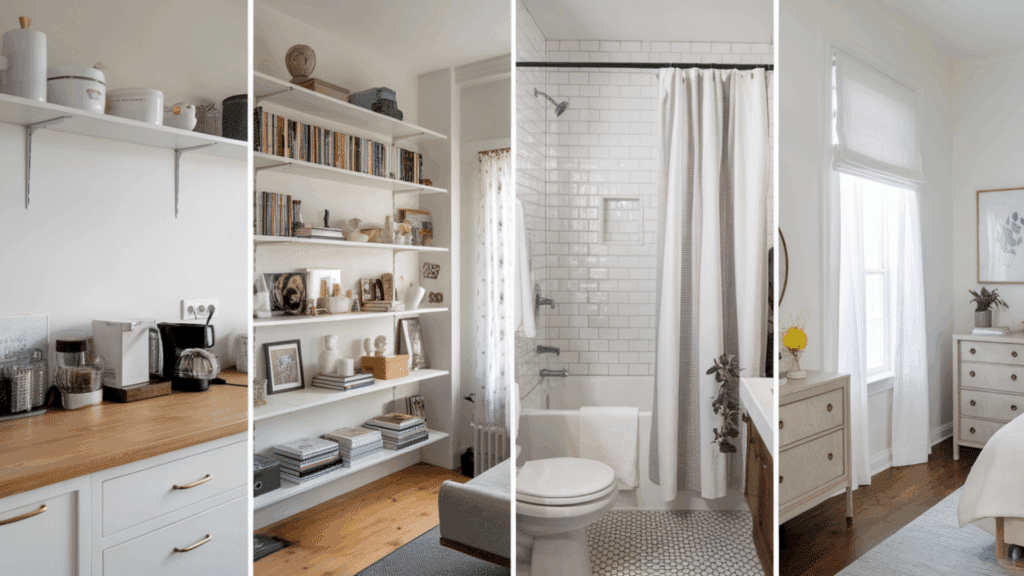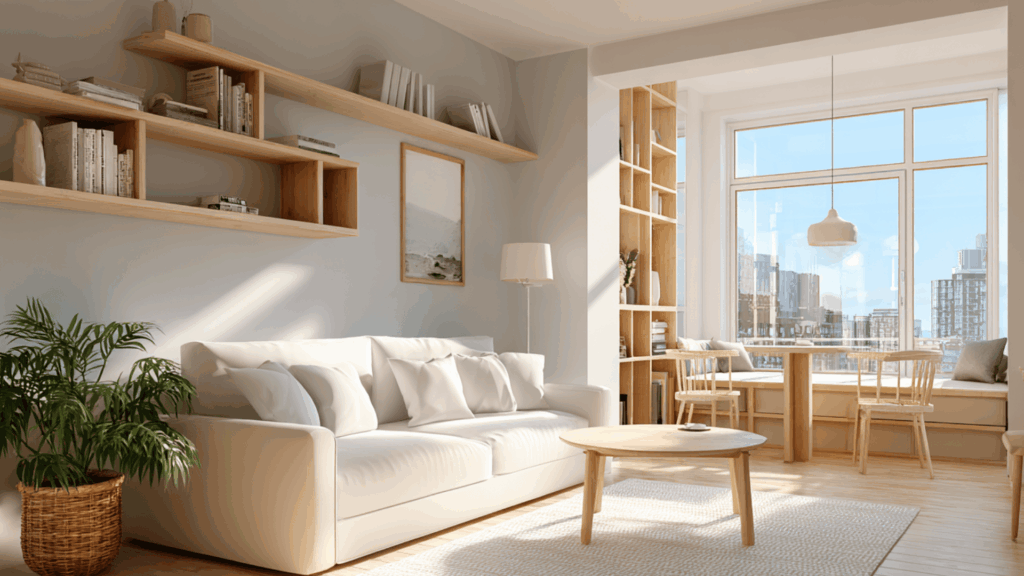Keeping your home organized can make life a lot easier. When everything has a place, you save time, feel calmer, and enjoy being in your space more.
I’ve learned that small changes, like using clear bins, adding labels, and cleaning one room at a time, can make a huge difference.
This guide brings together practical home organization ideas for every part of your house.
From your kitchen and closets to your office and garage, you’ll find simple, realistic ways to cut clutter and keep things neat without spending a lot of time or money.
Organizing Principles That Keep Any Space Tidy
A few simple rules can make any room easier to keep clean and clutter-free.
- Zone by Task: Keep items close to where you use them – like coffee mugs near the coffee maker.
- Contain and Label: Use baskets or bins to group similar things and add clear labels.
- Use Vertical Space: Add shelves, hooks, or wall racks to free up floor areas.
- Keep It Simple: Don’t over-organize; easy systems are the ones you’ll actually maintain.
Try using these steps as a foundation before organizing each room. Once you build simple systems, staying tidy becomes almost automatic.
Room-by-Room Home Organization Ideas
Keeping your home organized doesn’t have to be stressful. With the right approach, you can turn even the most cluttered rooms into calm, practical spaces.
Kitchen Organization
The kitchen is often the heart of the home, but it can quickly become chaotic with all the cooking, eating, and cleaning that happens daily. These smart storage ideas will help you create a space that’s both beautiful and functional.
1. Use Clear Pantry Bins
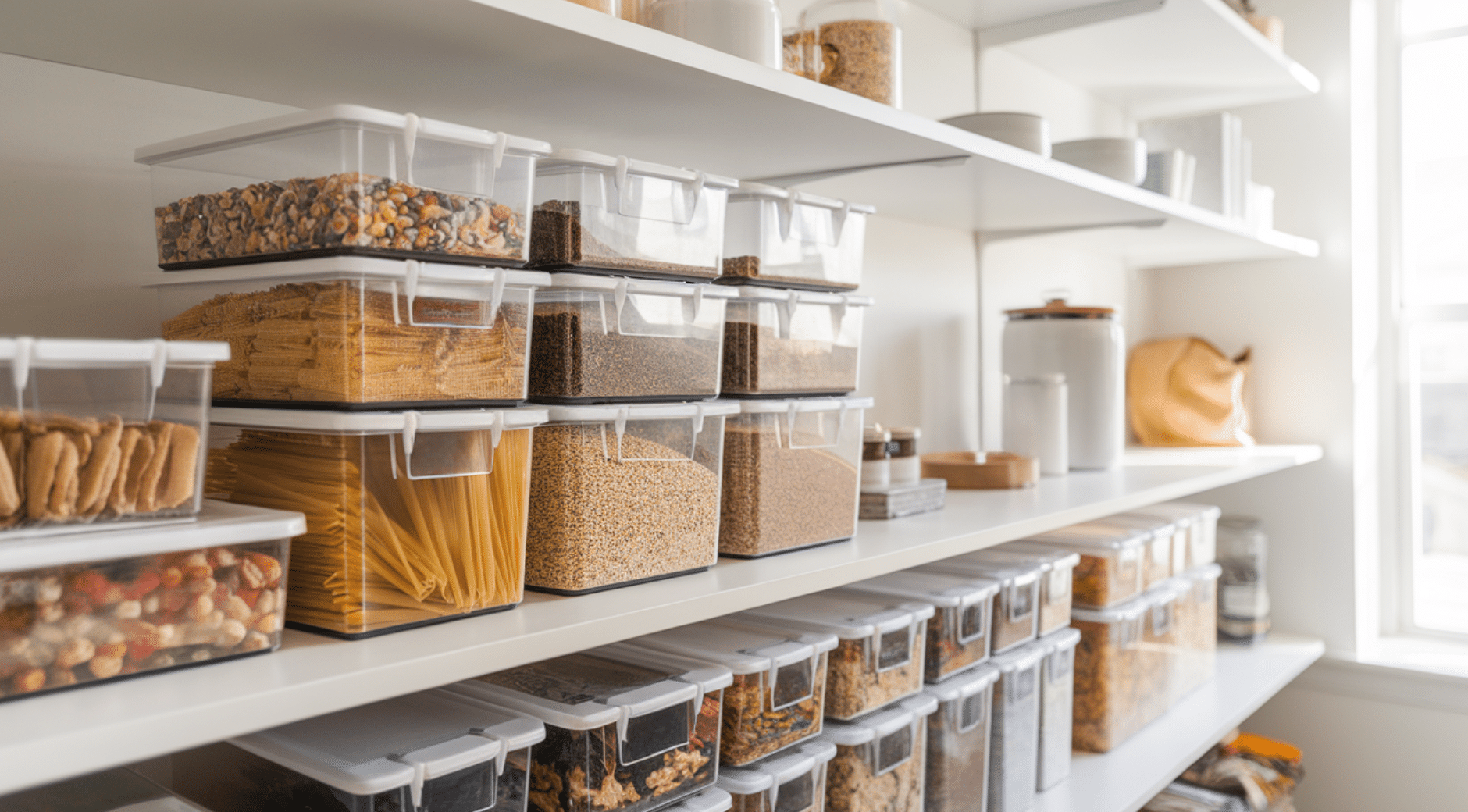
Storing dry foods, snacks, and baking ingredients in clear bins makes everything easier to find. You’ll spend less time searching and more time cooking.
Choose uniform bins for a clean look and label each one by category – like “pasta,” “grains,” or “snacks.” Stackable designs also help you maximize vertical space on shelves.
2. Create a Snack Zone
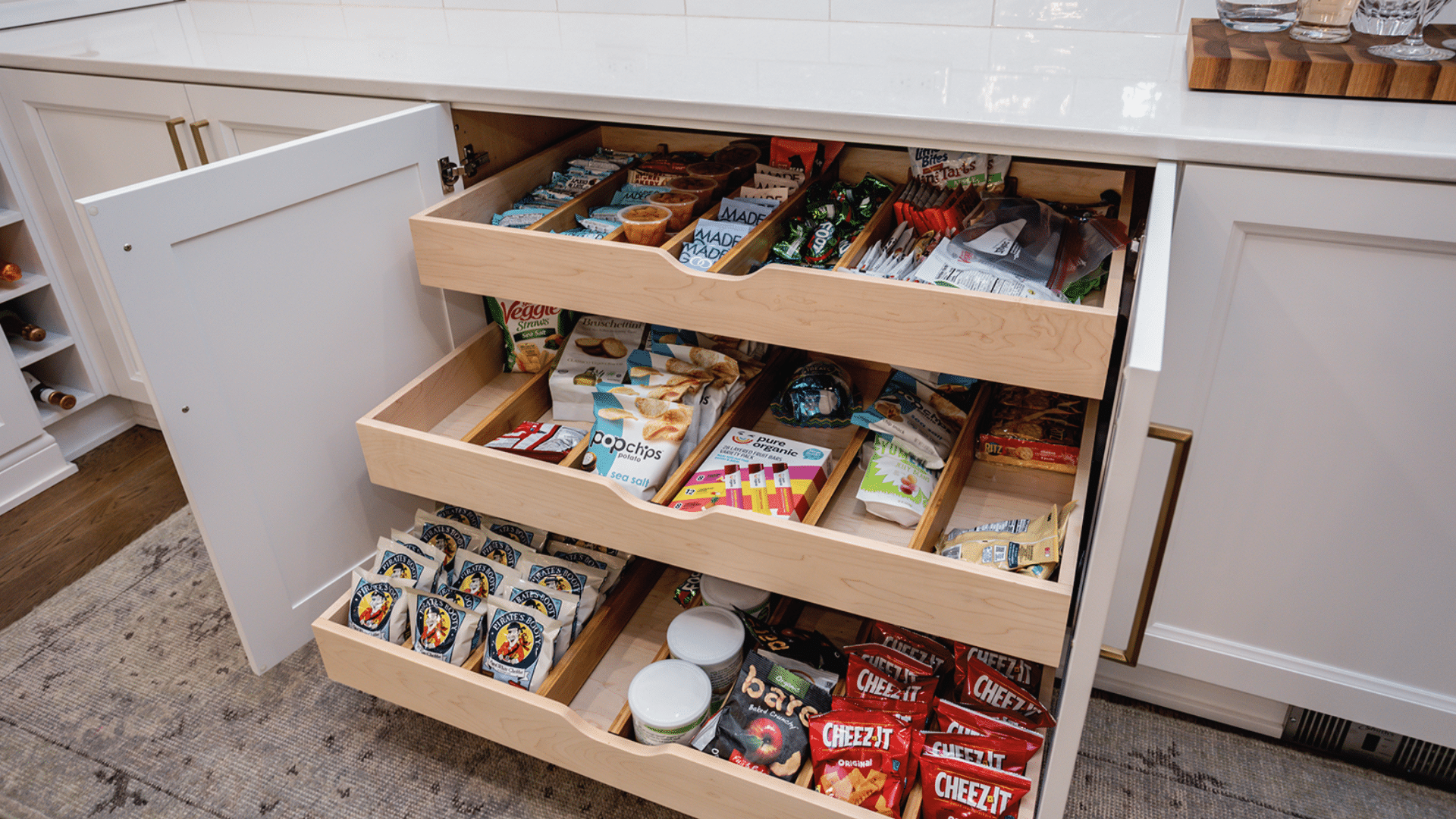
Set up one dedicated cabinet or basket just for snacks. Keep kids’ lunch items, bars, and treats grouped together so they’re easy to grab. This stops constant rummaging through the pantry and helps you track what needs restocking.
You can also place this snack zone on a lower shelf so kids can reach it easily, making after-school snacking more independent and organized.
3. Try a Lazy Susan
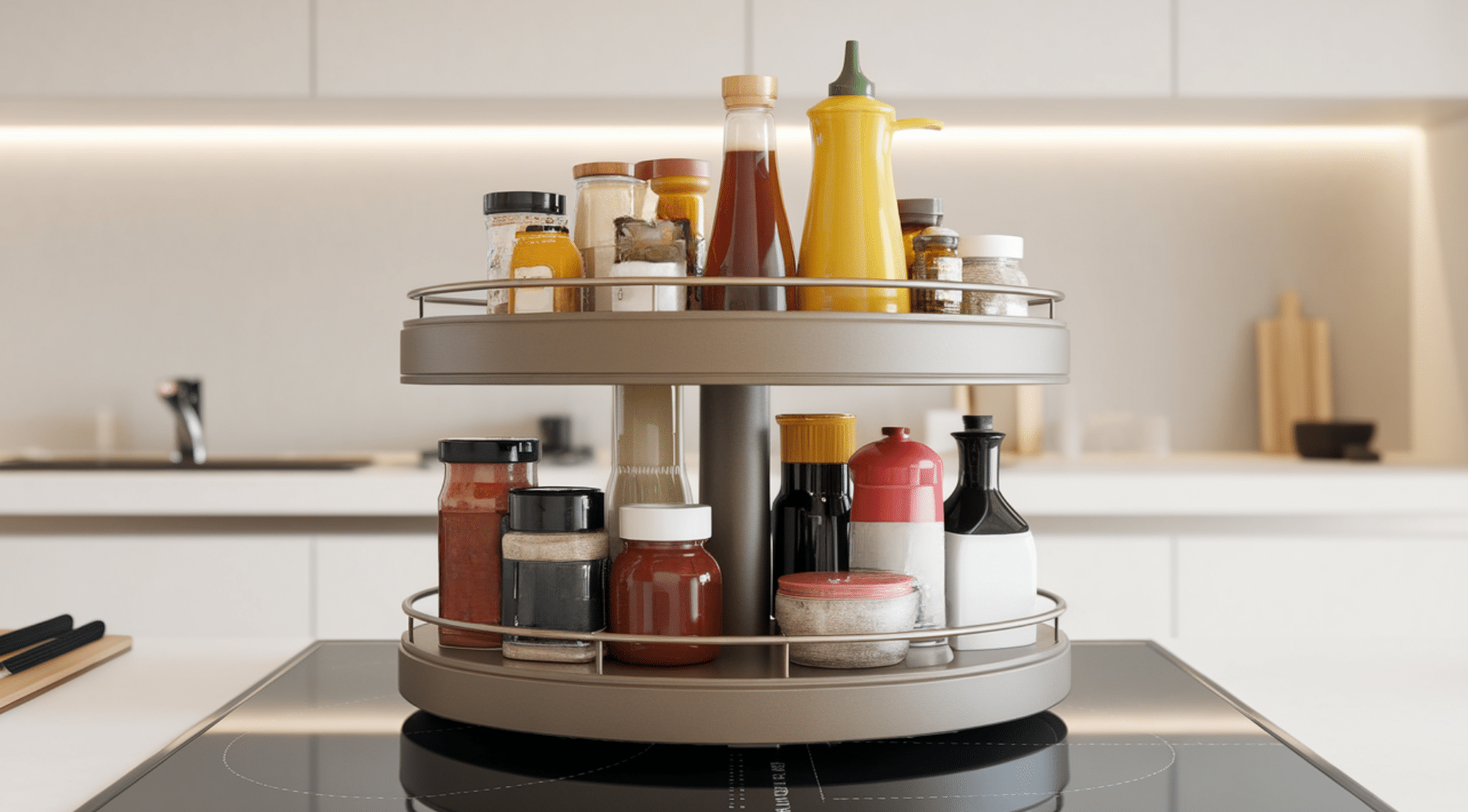
A lazy Susan is perfect for deep cabinets or fridge corners where things get lost. It keeps bottles, condiments, and spices visible and within easy reach.
Opt for a sturdy one with high edges to keep items secure when rotating. It’s a small upgrade that instantly adds efficiency to your kitchen setup.
4. Install Drawer Dividers
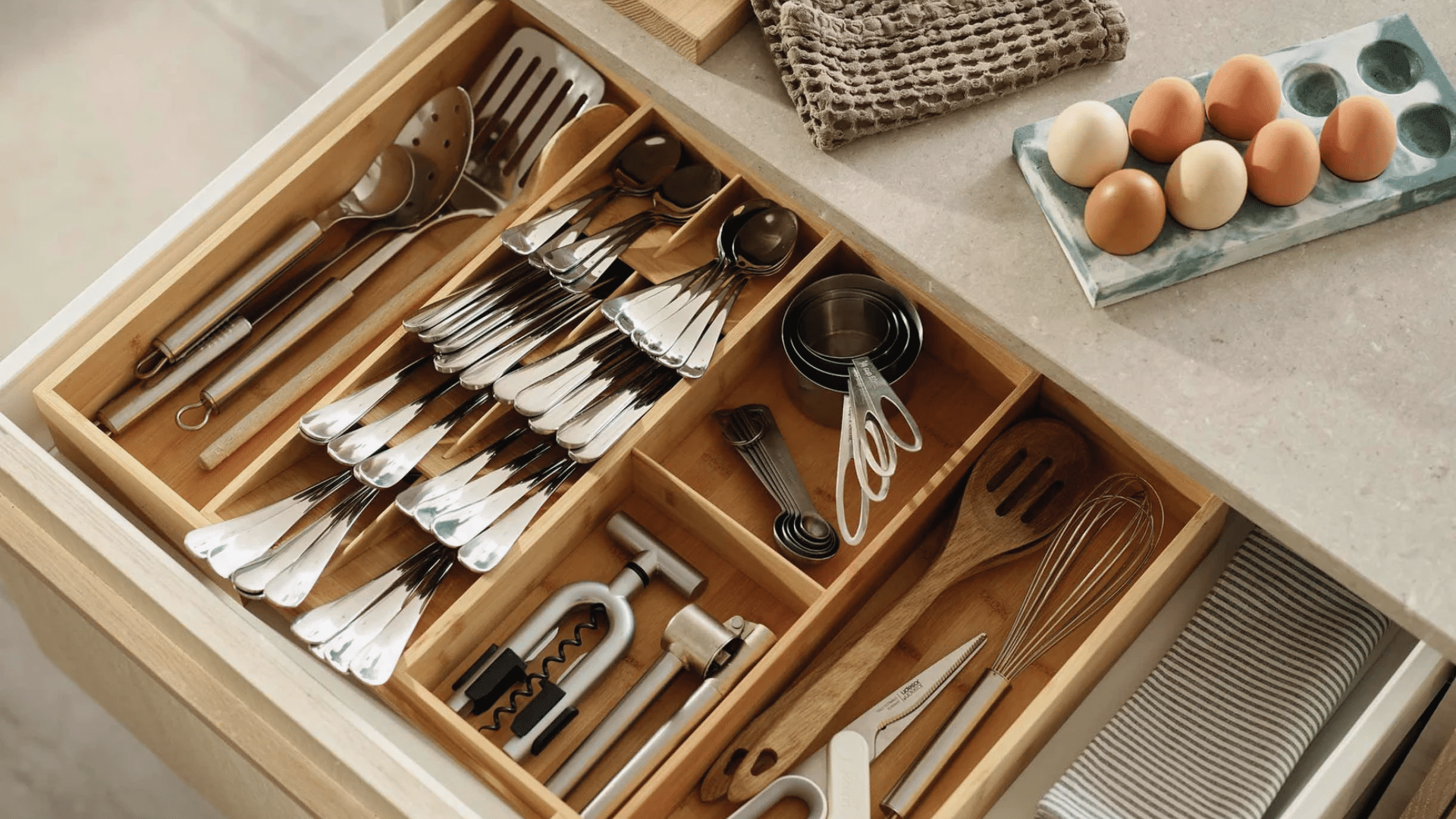
Drawer dividers keep utensils, measuring tools, and kitchen gadgets separated and easy to find. Adjustable ones are ideal because you can customize the layout as your needs change.
This system prevents overcrowded drawers and keeps even the smallest items in their place, helping you maintain order day after day.
5. Use Drawer-Front Organizers
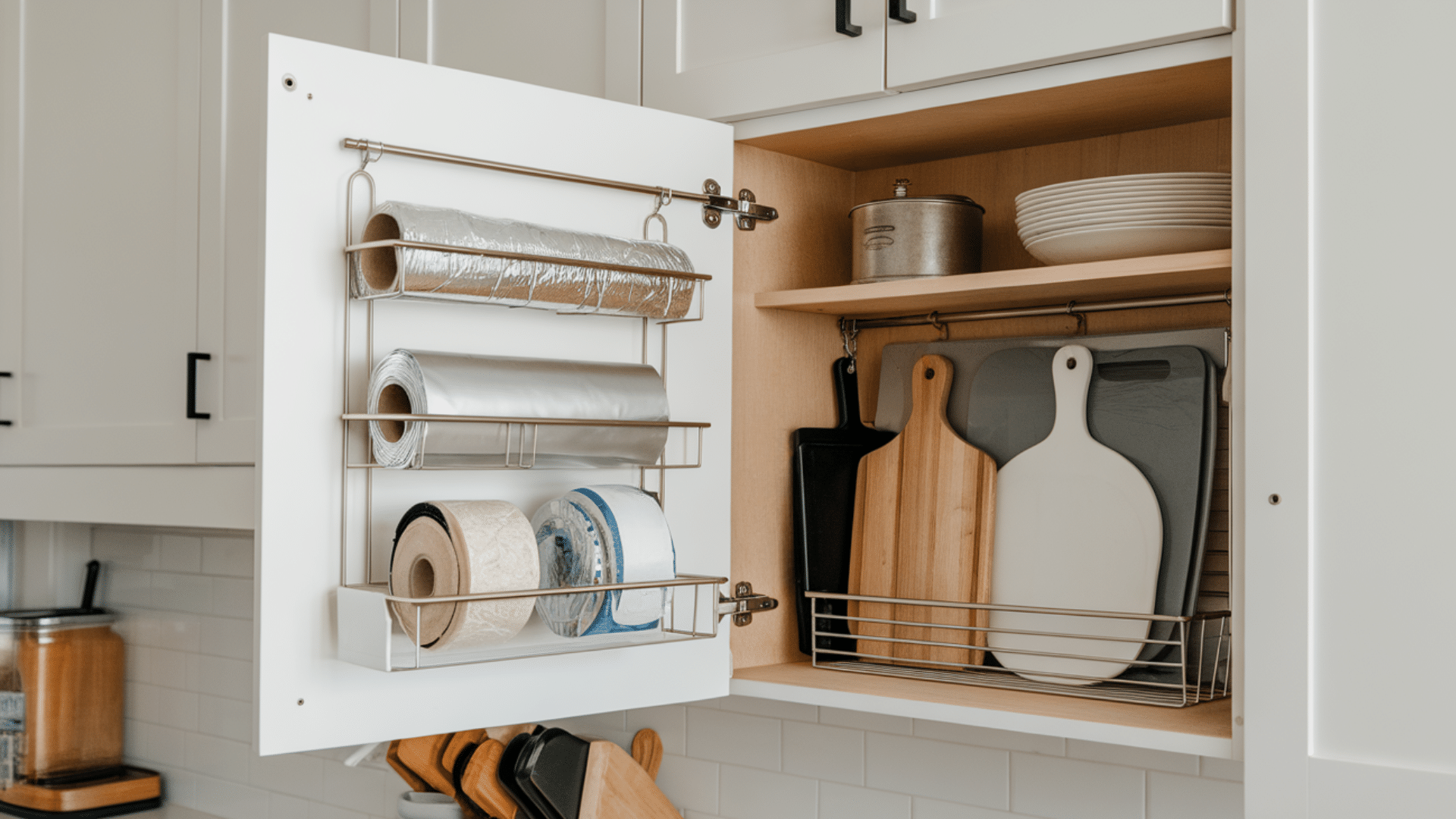
Attach small adhesive or screw-on organizers to the inside of cabinet doors or drawer fronts. They’re ideal for storing foil, wraps, tissue rolls, and cutting boards flat, without cluttering shelves.
It’s an often-overlooked space that adds convenience and keeps your kitchen looking clean
6. Organize Under the Sink
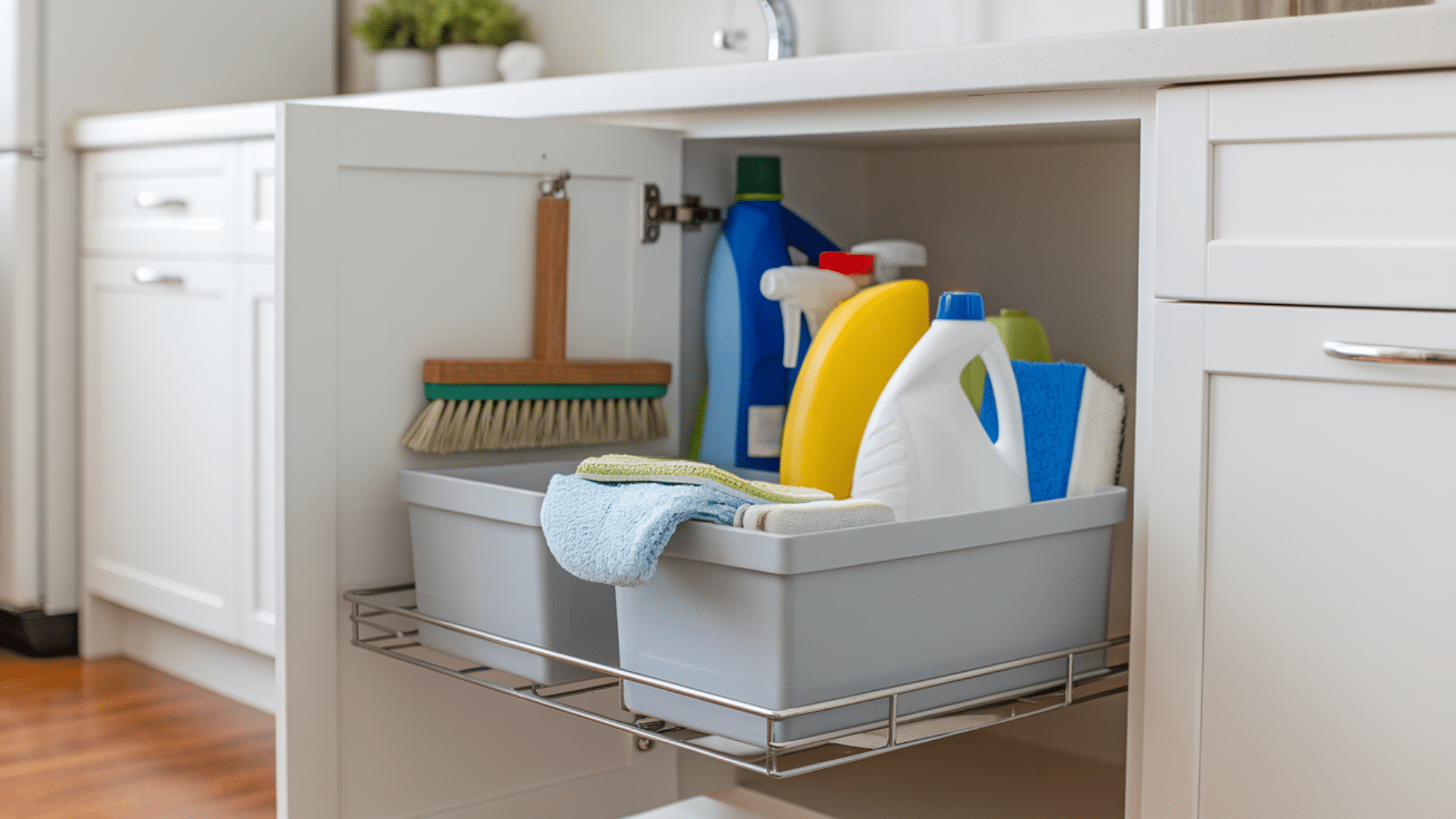
The space beneath your sink can get cluttered fast, so use pull-out bins or caddies for cleaning products. Store items by type, like sponges, sprays, or dish soaps, and group backups separately.
Adding a tension rod for hanging spray bottles frees up even more space below.
7. Use Shelf Risers
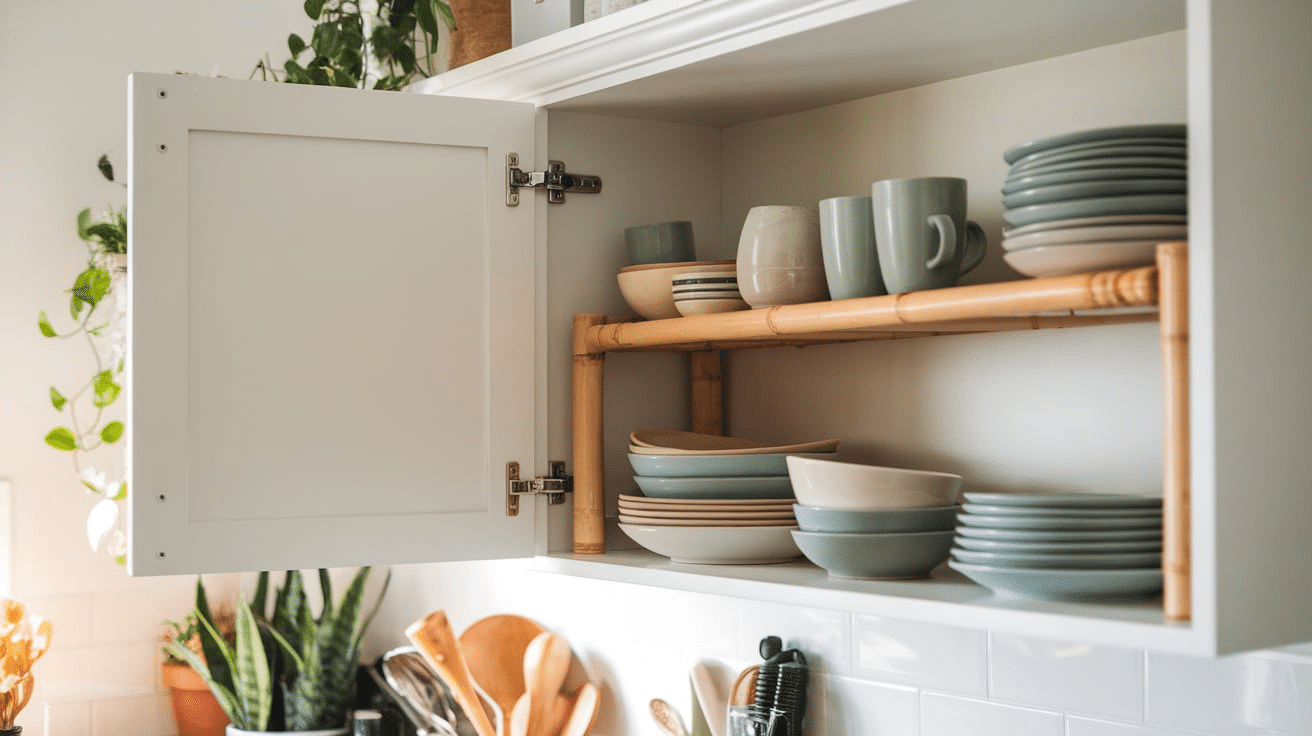
Shelf risers instantly double the usable space in your cabinets. They allow you to stack plates, cups, or food containers without worrying about tipping them over.
Choose sturdy metal or bamboo risers for long-term durability and easy access to everything you use daily.
Living Room & Entryway Organization
The living room and entryway are the first spaces people see when they walk into your home. Keeping them tidy makes a great first impression and helps you feel more relaxed at the end of the day.
8. Add a Storage Ottoman
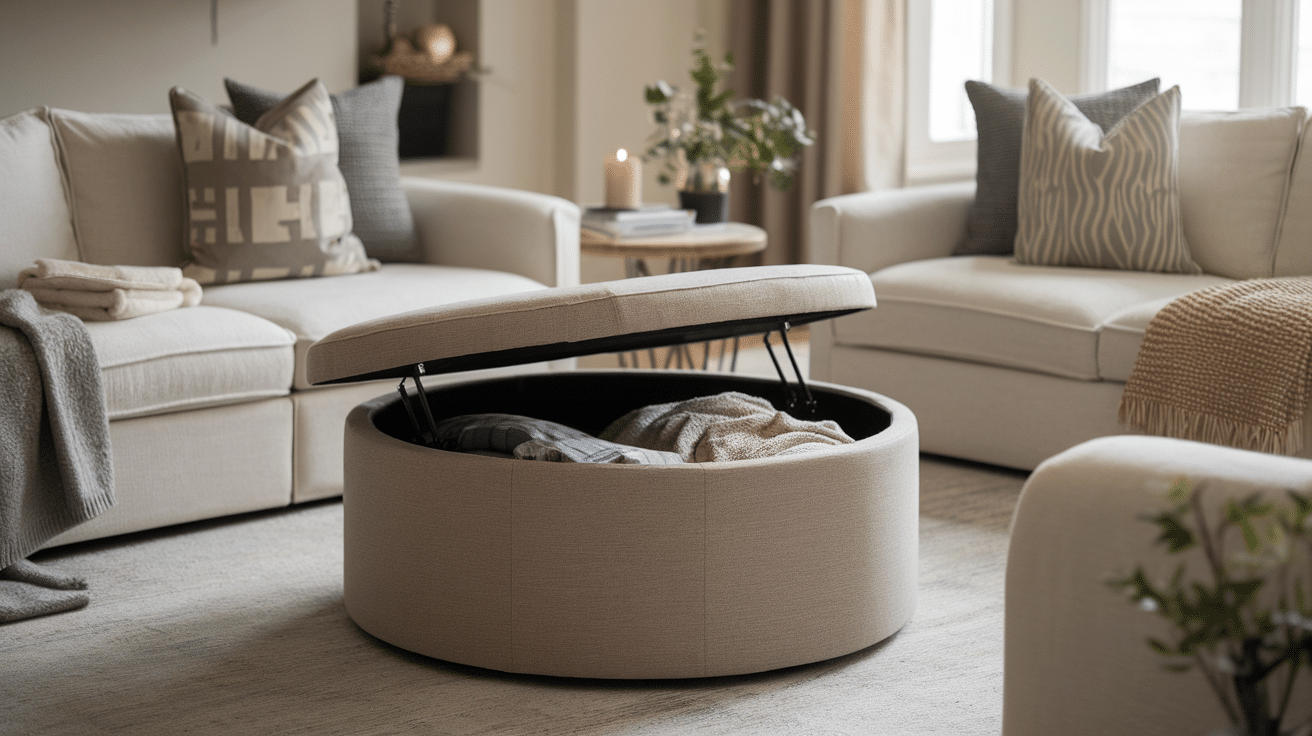
A storage ottoman is both stylish and useful – it gives you a place to rest your feet while hiding extra blankets, remotes, or board games inside.
Choose one with a removable top for easy access and match it to your furniture for a seamless look. It’s a simple way to reduce clutter while adding cozy comfort to your space.
9. Use Entryway Baskets
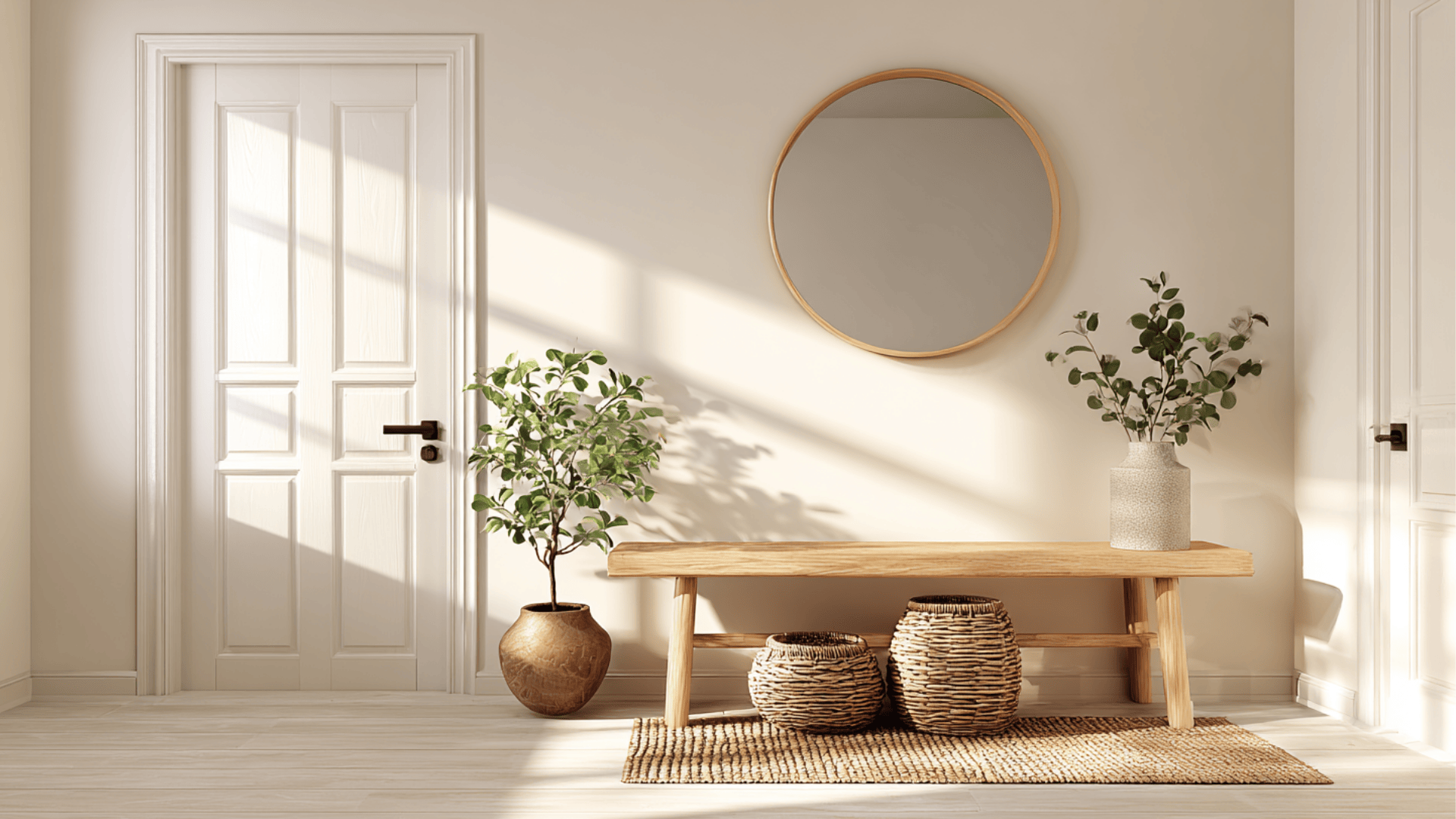
Place baskets near the door to hold shoes, umbrellas, or small items like gloves and scarves. Give each family member their own basket so they can quickly grab what they need and put it back later.
Woven or lidded baskets also add texture and warmth to your entryway décor.
10. Use a Console Table with Drawers
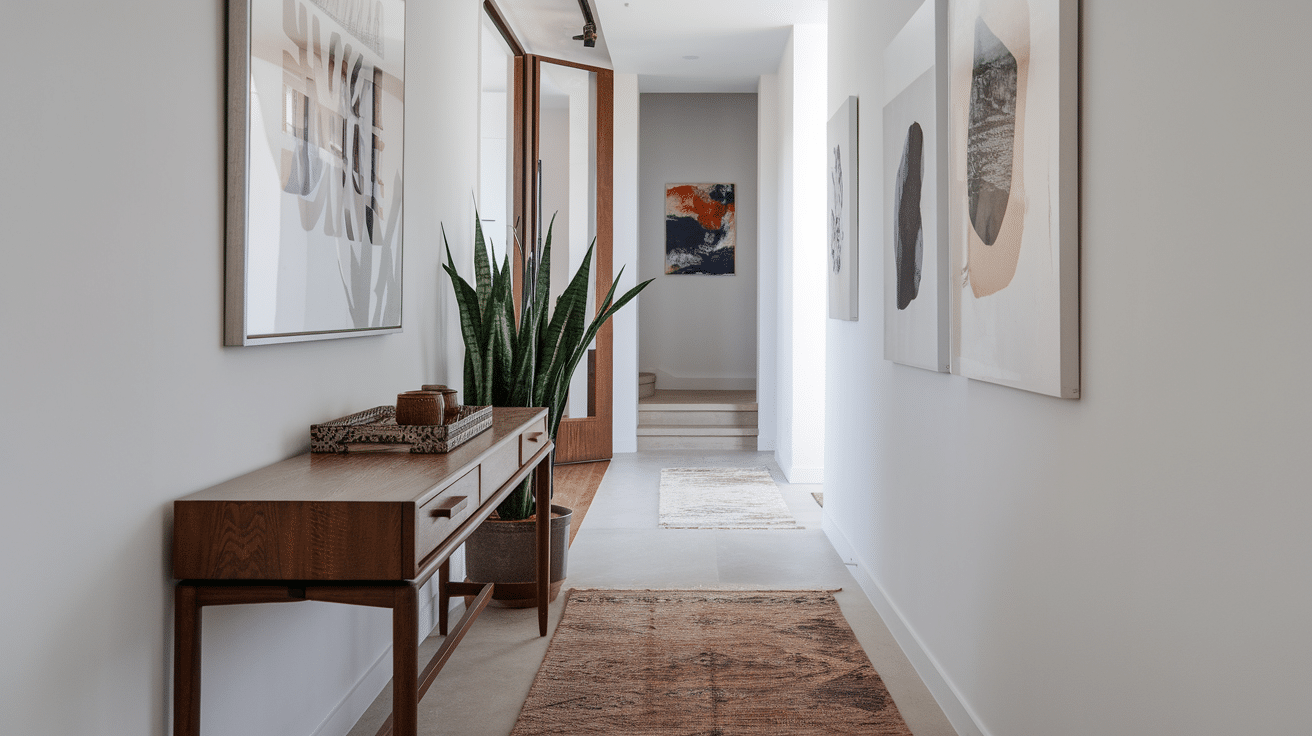
A slim console table near your entryway can store small items like mail, chargers, or sunglasses. The drawers hide visual clutter while the top can display décor. It’s a stylish and functional solution for narrow spaces.
You can also add a small tray or bowl on top for keys and loose change to keep everyday essentials within easy reach.
11. Add a Wall-Mounted Coat Rack
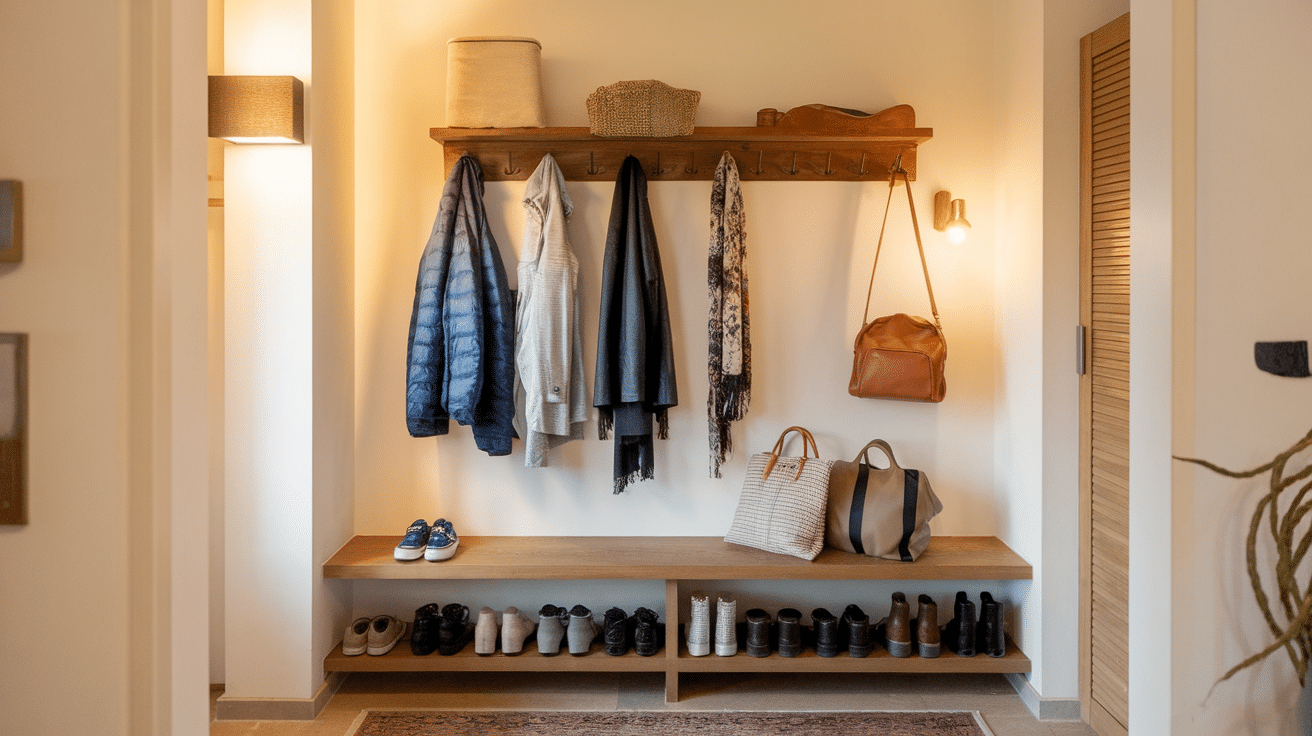
Install a sturdy wall-mounted coat rack in your entryway to keep jackets, bags, and hats off the floor. Choose one with multiple hooks or pegs so every family member has a spot.
It’s a simple upgrade that keeps your entry neat and makes it easy to grab things on your way out.
12. Add Floating Shelves
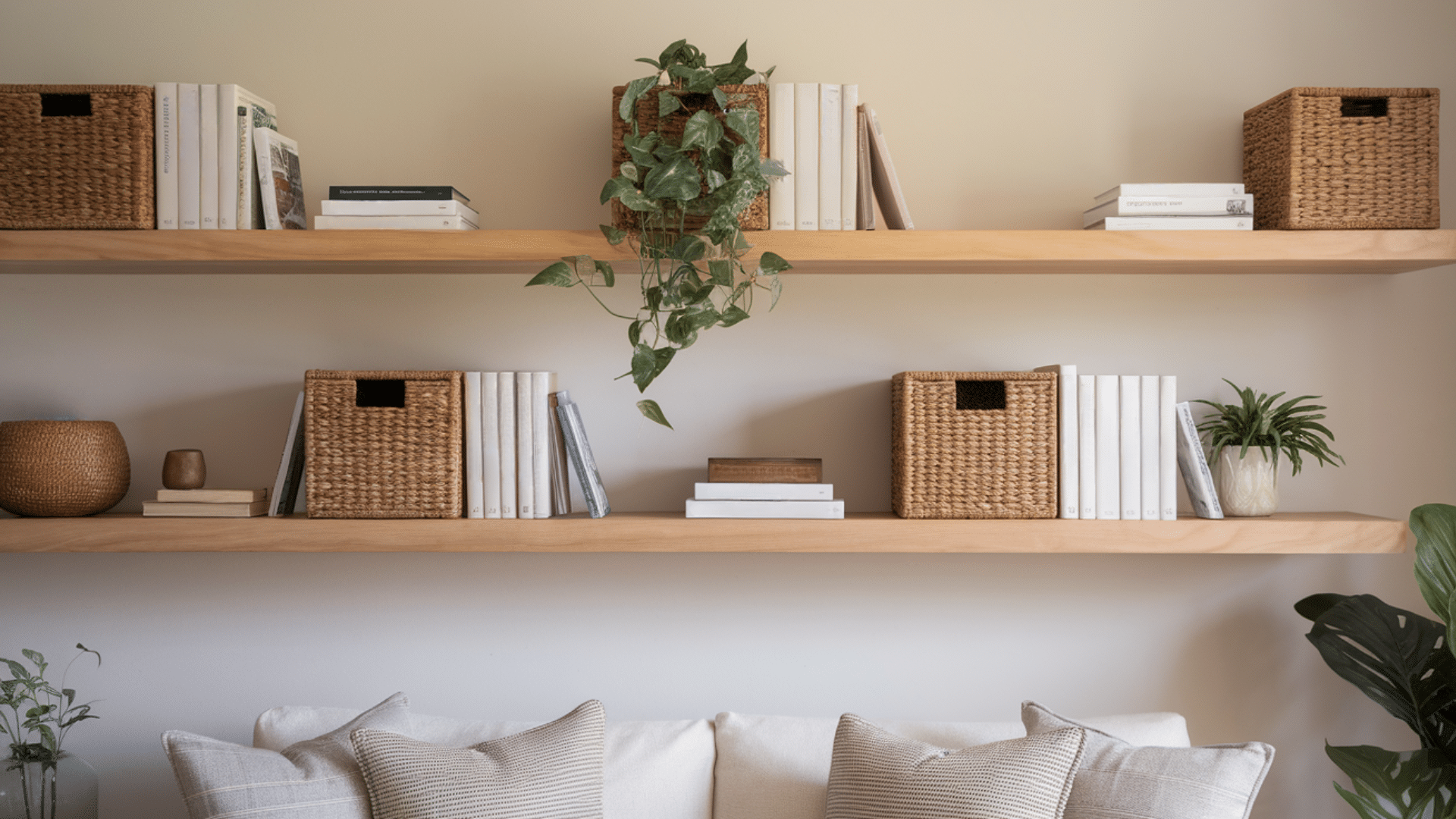
Floating shelves help you display décor, plants, or books without taking up valuable floor space. Use a mix of open and closed baskets on the shelves for hidden storage.
Keeping the display balanced and uncluttered creates a cozy yet organized look that feels intentional.
13. Hide Cables with a Cord Box
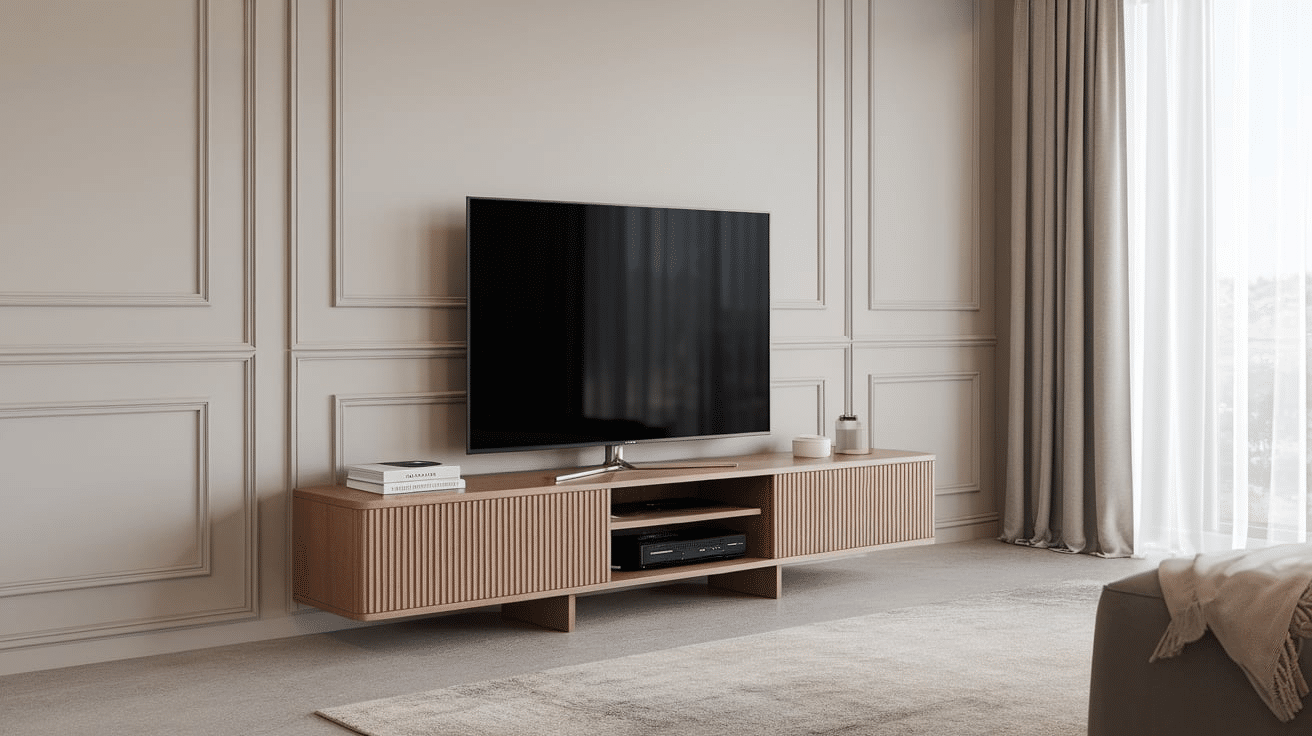
If your living room has a TV, gaming console, or sound system, cords can quickly create visual chaos.
A simple cord management box or zip sleeve keeps wires neatly bundled and out of sight. It makes the area safer, tidier, and much easier to clean.
14. Create a Key and Essentials Station
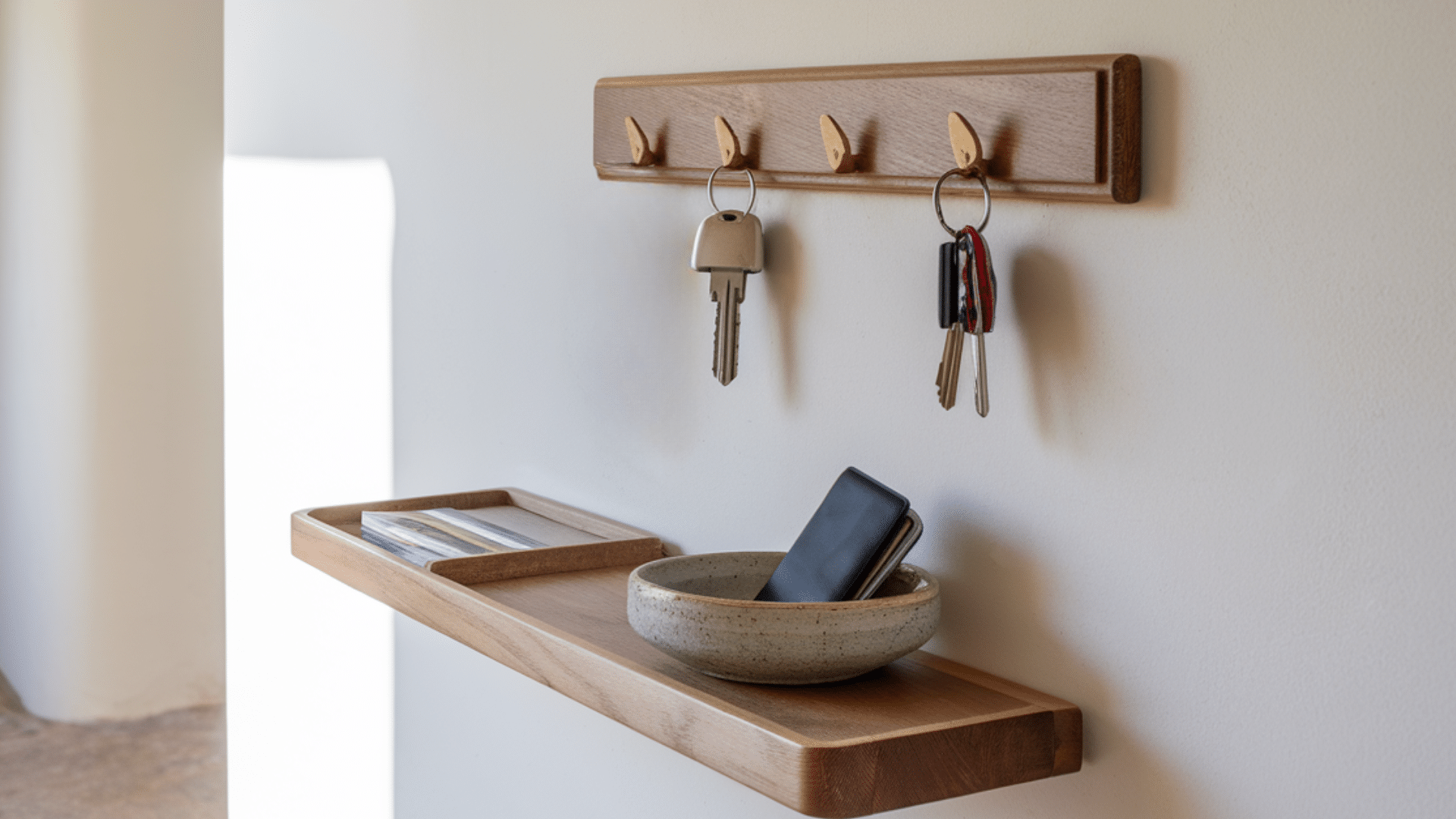
Mount a small shelf or use a wall-mounted organizer to keep keys, wallets, and sunglasses in one spot.
This setup eliminates the daily scramble to find your essentials before heading out. It also adds a small touch of structure to your entryway routine.
Bedroom & Closet Organization Systems
A tidy bedroom makes it easier to unwind and start your day with a clear mind. The key is to create systems that make it effortless to put things away.
15. File-Fold Clothing
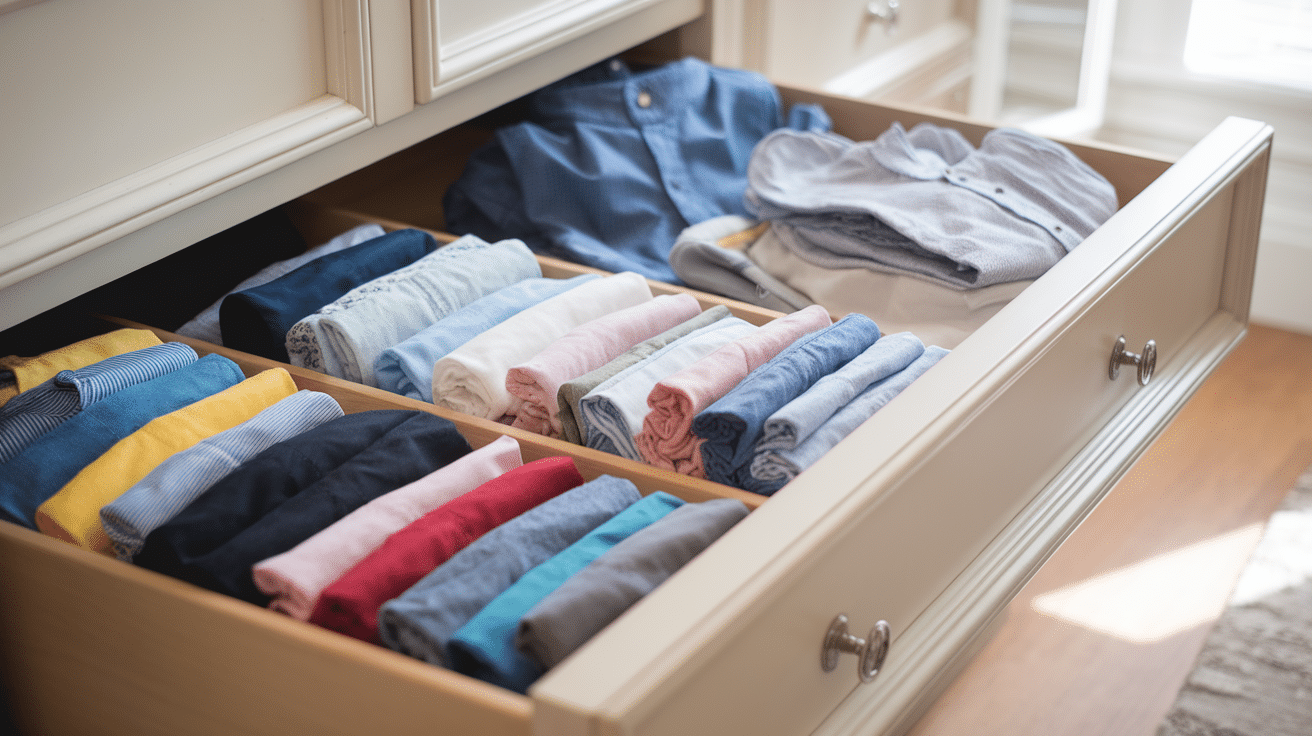
Instead of stacking shirts or pants, try the file-fold method – standing clothes upright so you can see every item at once.
This saves space, prevents wrinkles, and makes it easy to pick outfits. You’ll also stop wearing the same few things because you can finally see what you own.
16. Use Slim, Matching Hangers

Swap bulky hangers for slim velvet or wood ones to instantly create more hanging space. Matching hangers also make your closet look neater and more cohesive.
This small change helps clothes hang evenly and keeps items from slipping onto the floor.
17. Add Shelf Dividers
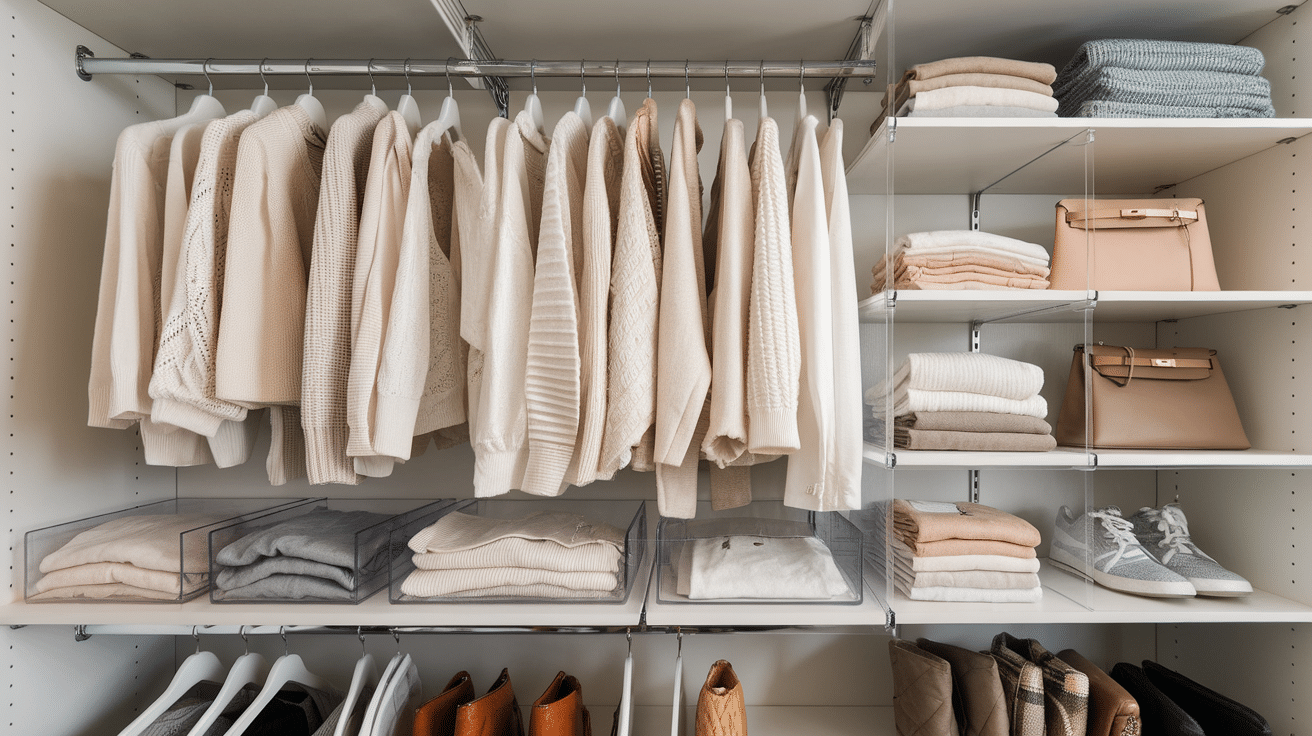
If your closet shelves look messy, dividers can keep piles of sweaters, jeans, or handbags in order. They stop stacks from toppling and make it easier to find what you need.
Clear acrylic or wire dividers work best since they don’t block visibility. They’re easy to install and remove, so you can adjust or rearrange them anytime your wardrobe changes.
18. Use Drawer Organizers
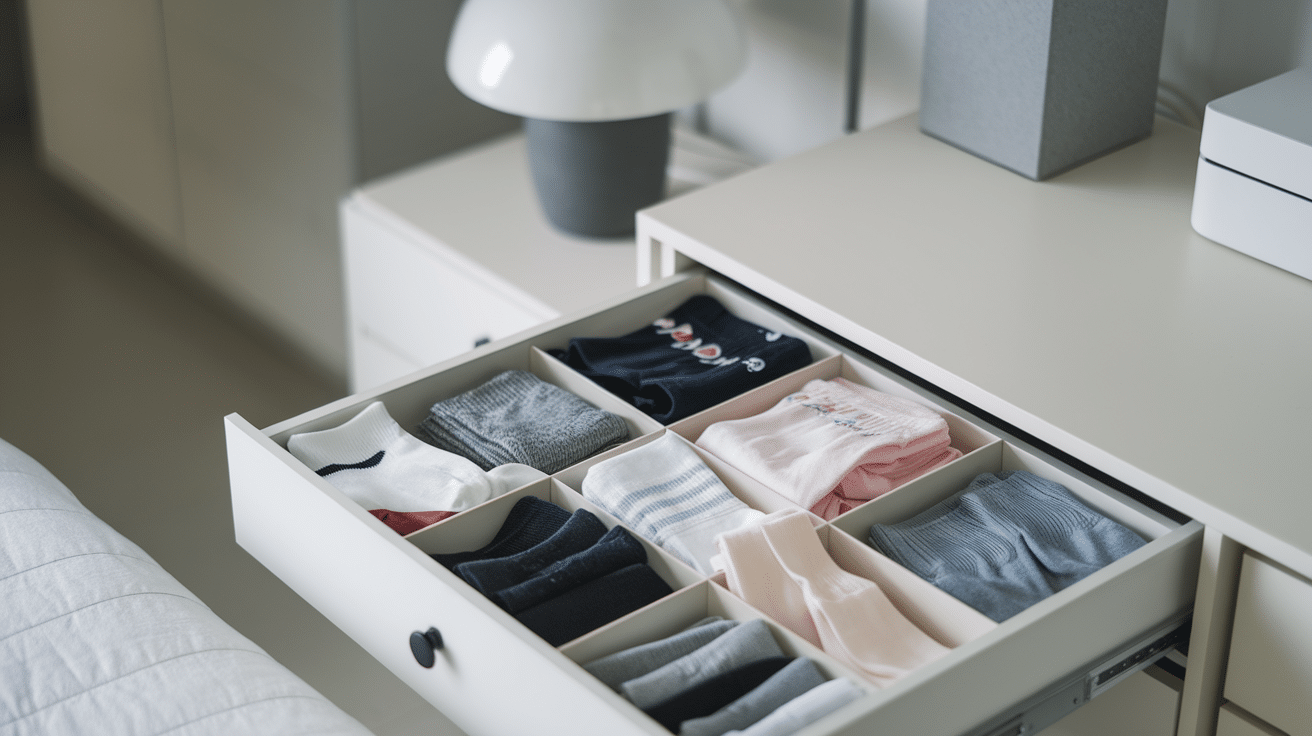
Drawer inserts or small boxes help separate socks, underwear, and accessories. Keeping everything in its own section saves time when getting dressed and stops smaller items from getting lost.
It also encourages you to keep drawers tidy without much effort.
19. Create a Seasonal Rotation Bin
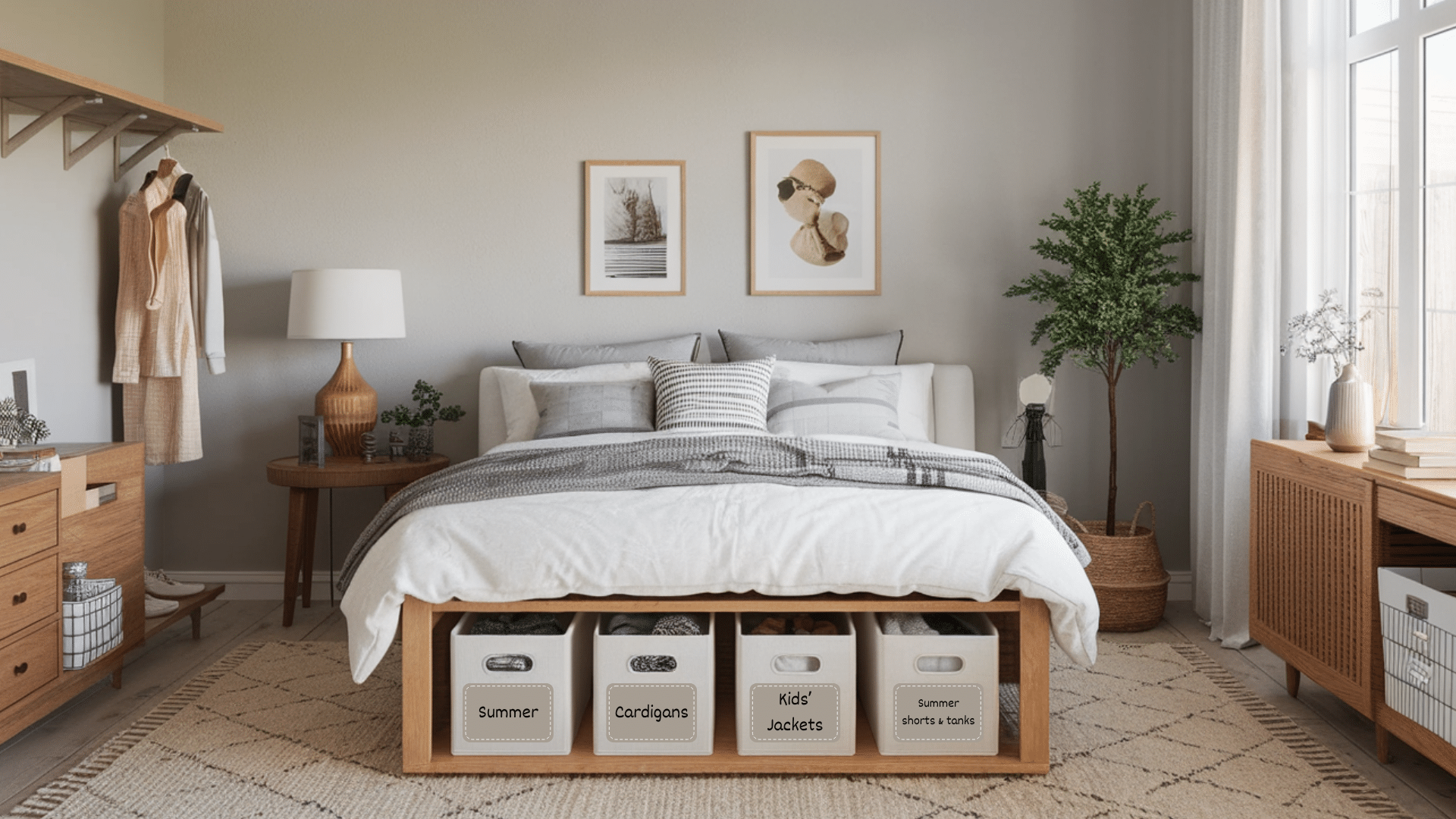
Store off-season clothes in labeled bins or under-bed containers to free up space for current items. This keeps your closet from overflowing and helps you stay focused on what you actually wear.
This simple habit also makes it easier to spot what you no longer use, so donating or selling unused pieces becomes effortless.
20. Install a Closet Lighting Strip
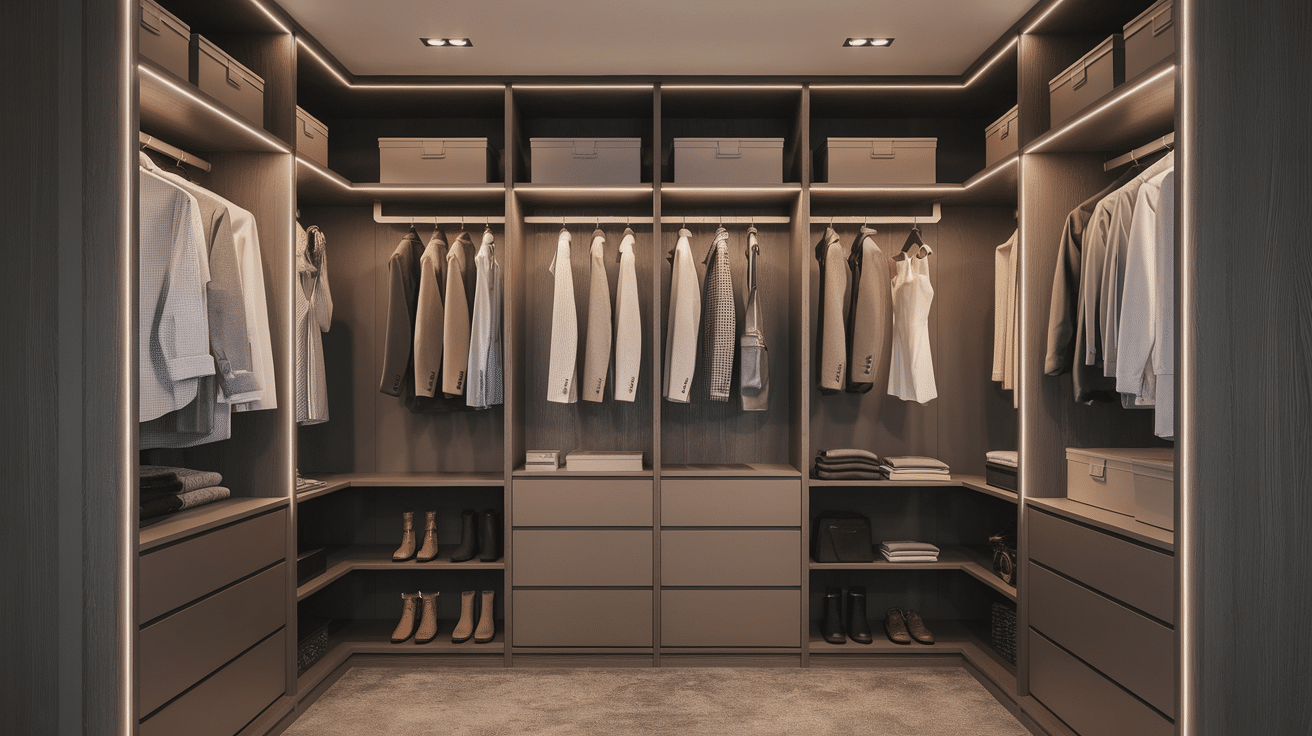
Add motion-sensor LED lights under closet shelves or along hanging rods. It brightens dark spaces, helps you find items faster, and gives your closet a polished feel.
It’s especially useful in older homes with limited lighting. These lights are energy-efficient and battery-powered, making them easy to install without any wiring or an electrician needed.
21. Keep a “Donate or Fix” Bin
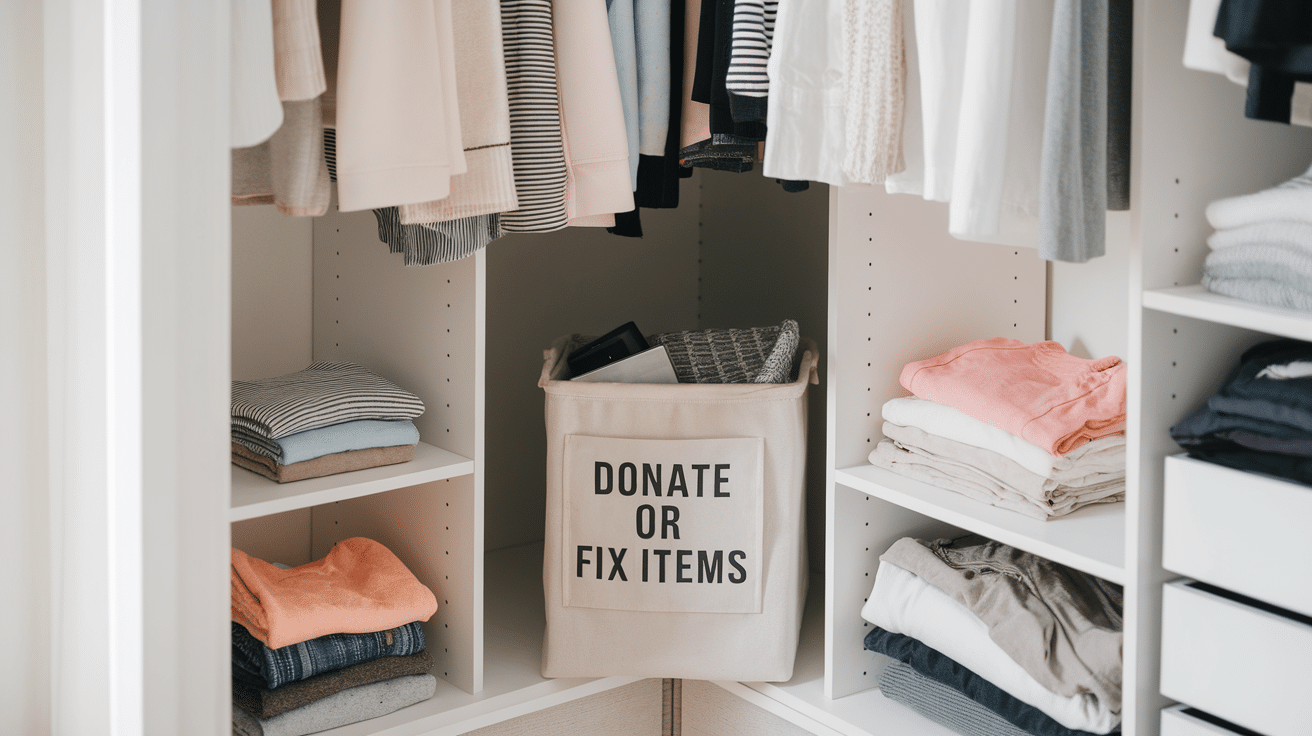
Keep a small bin in your closet for clothes that need mending or no longer fit. When it fills up, you’ll know it’s time to repair or donate.
This system keeps your wardrobe current and prevents unwanted items from piling up. It also saves time during closet cleanouts since you’ve already separated items that don’t belong in your regular rotation.
Bathroom Storage Organization
Bathrooms can easily become cluttered with toiletries, towels, and cleaning supplies. The goal is to create simple storage solutions that make everyday routines faster and more peaceful.
22. Use Drawer Inserts for Toiletries
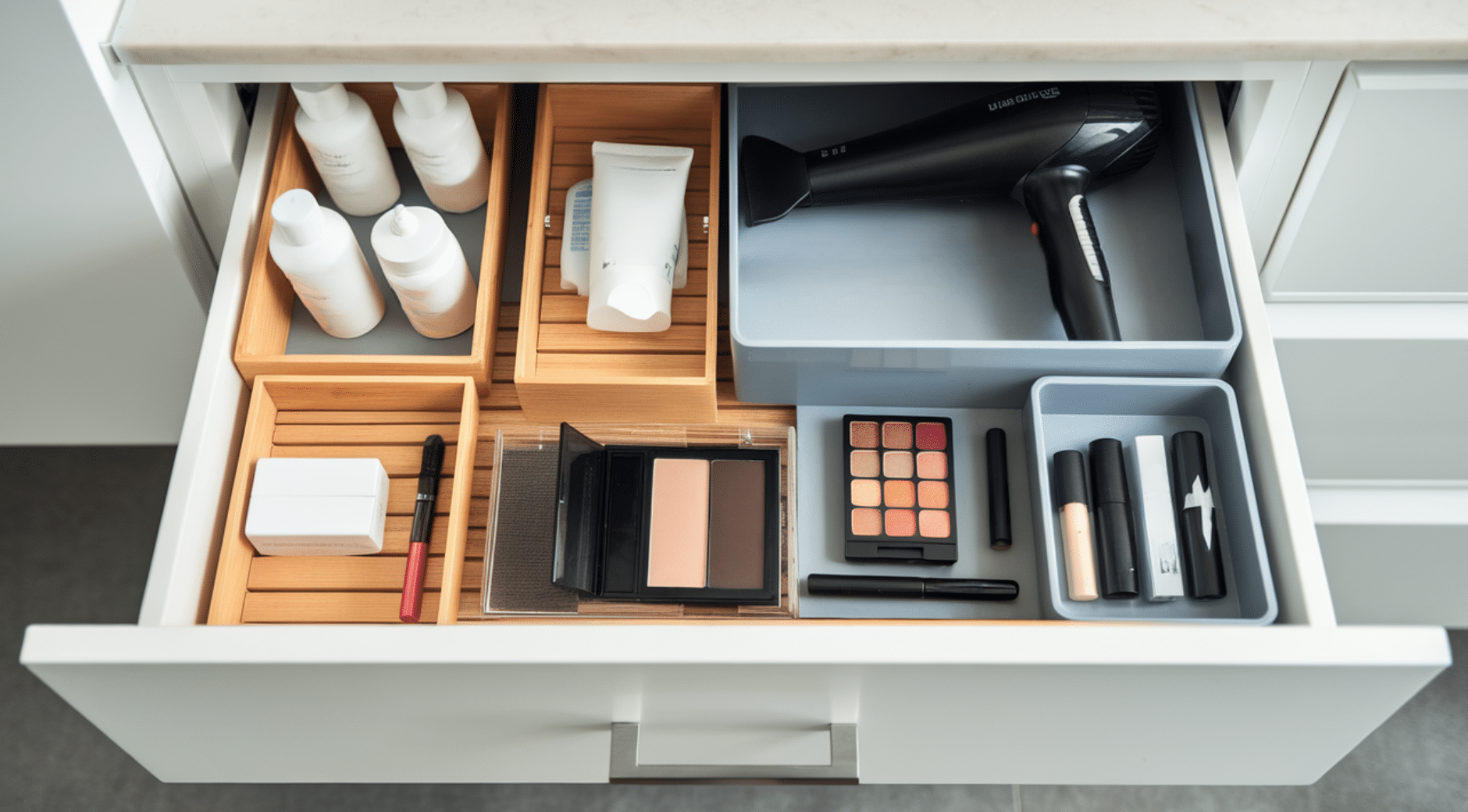
Bathroom drawers often turn into a jumble of small items. Drawer inserts help separate skincare, hair tools, and makeup so everything has a clear spot.
Choose plastic or bamboo organizers that are easy to clean and adjust them to fit your drawer sizes perfectly.
23. Add Over-the-Toilet Shelves
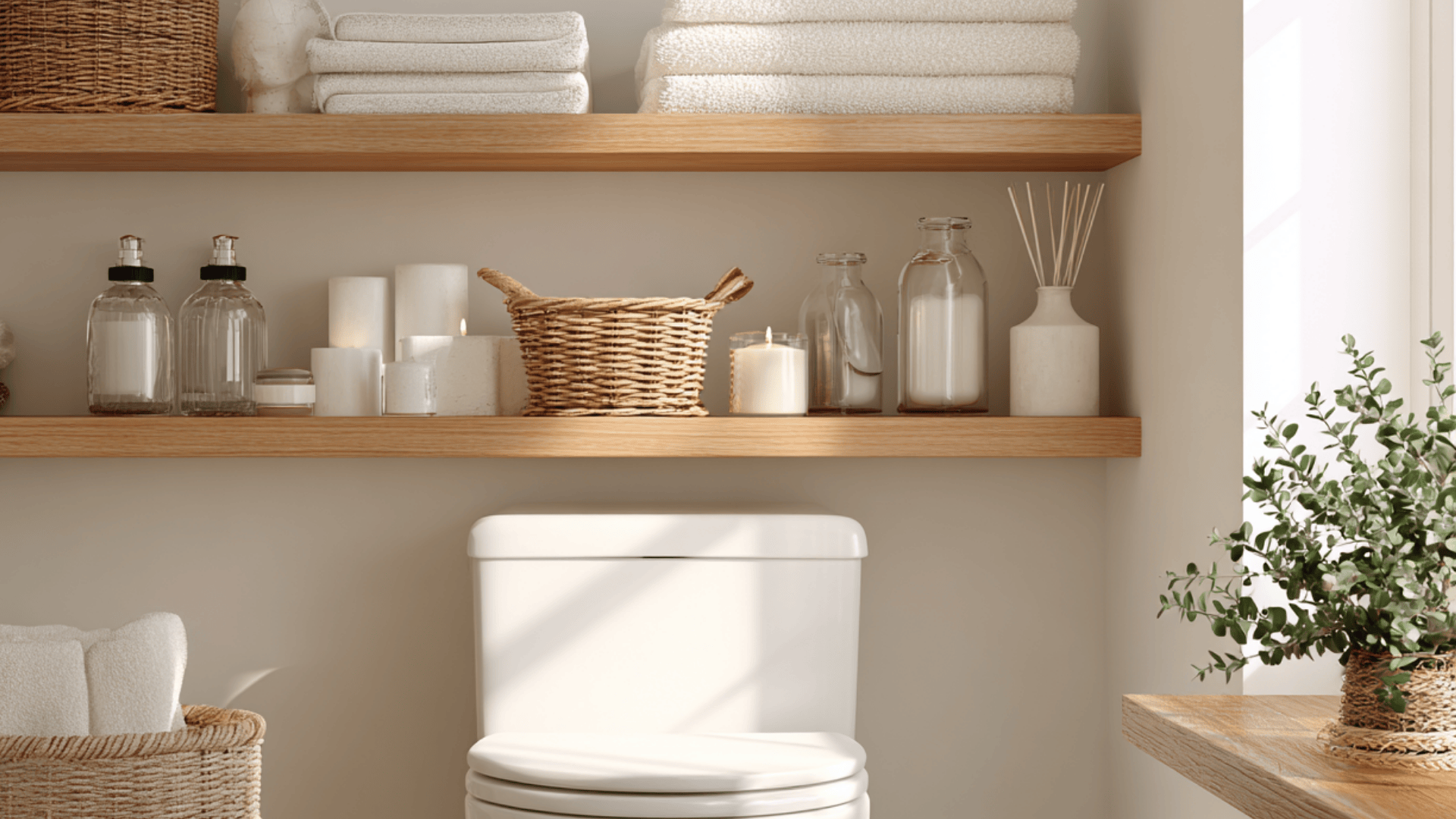
The space above your toilet is often wasted, but it’s perfect for open shelving. Use baskets or jars to store extra towels, toilet paper, or small décor pieces.
It gives your bathroom extra storage while keeping essentials close by. You can even add a small plant or scented candle on the top shelf to make the area feel fresh and inviting.
24. Create a Daily Essentials Tray
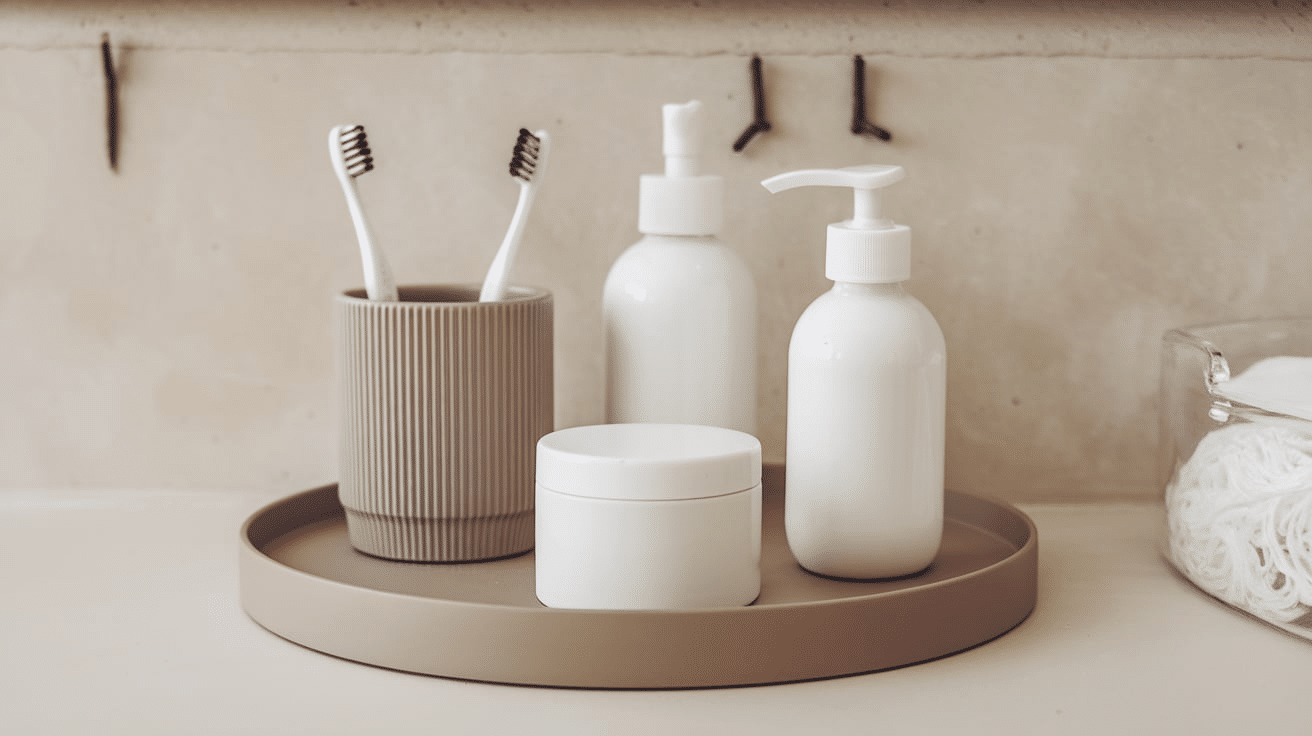
Keep your most-used items, like toothbrushes, skincare, or hand lotion, on a small tray or lazy Susan. It keeps your counter tidy while still being convenient for morning and evening routines.
When it’s time to clean, you can lift the tray and wipe underneath easily.
25. Use Clear Canisters for Small Items
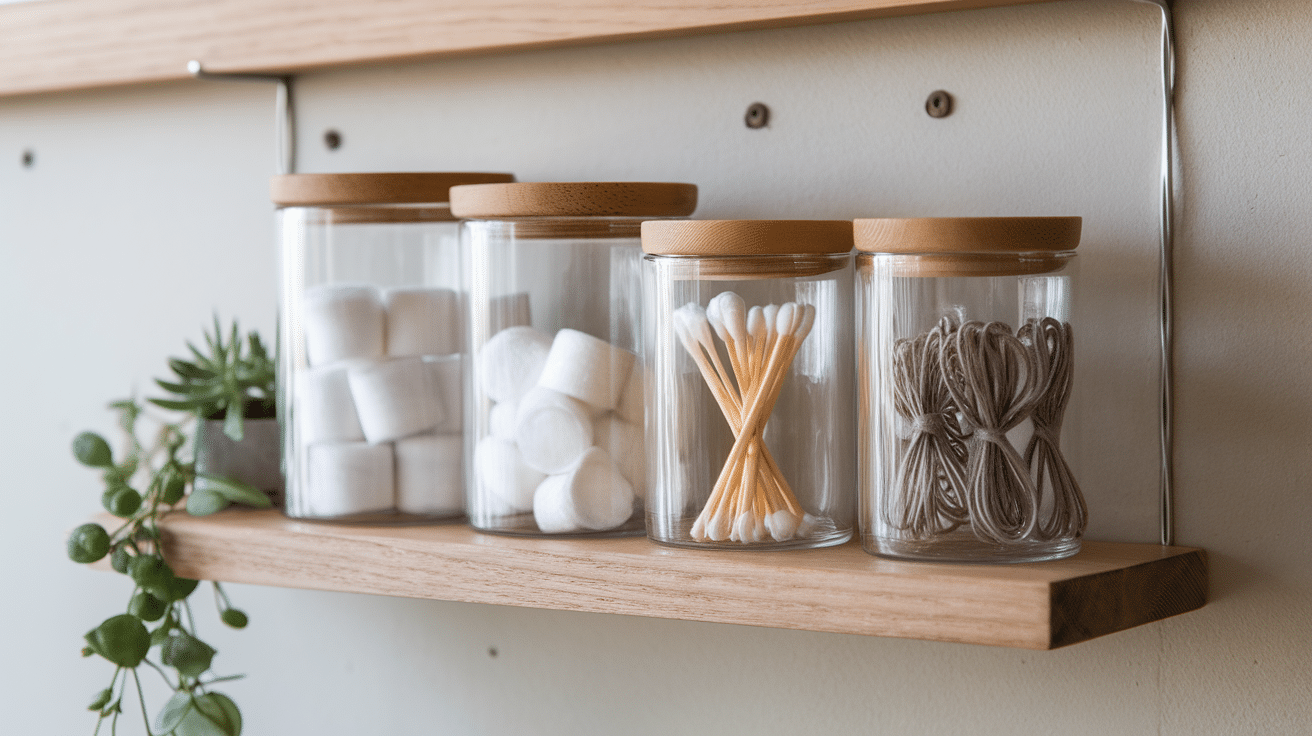
Cotton pads, Q-tips, and hair ties tend to scatter everywhere. Clear canisters or jars keep them visible and contained. Choose matching jars for a uniform look, and place them on open shelves or under the sink for easy access.
This keeps your bathroom looking neat and also makes restocking supplies quick and effortless.
26. Install a Shower Caddy
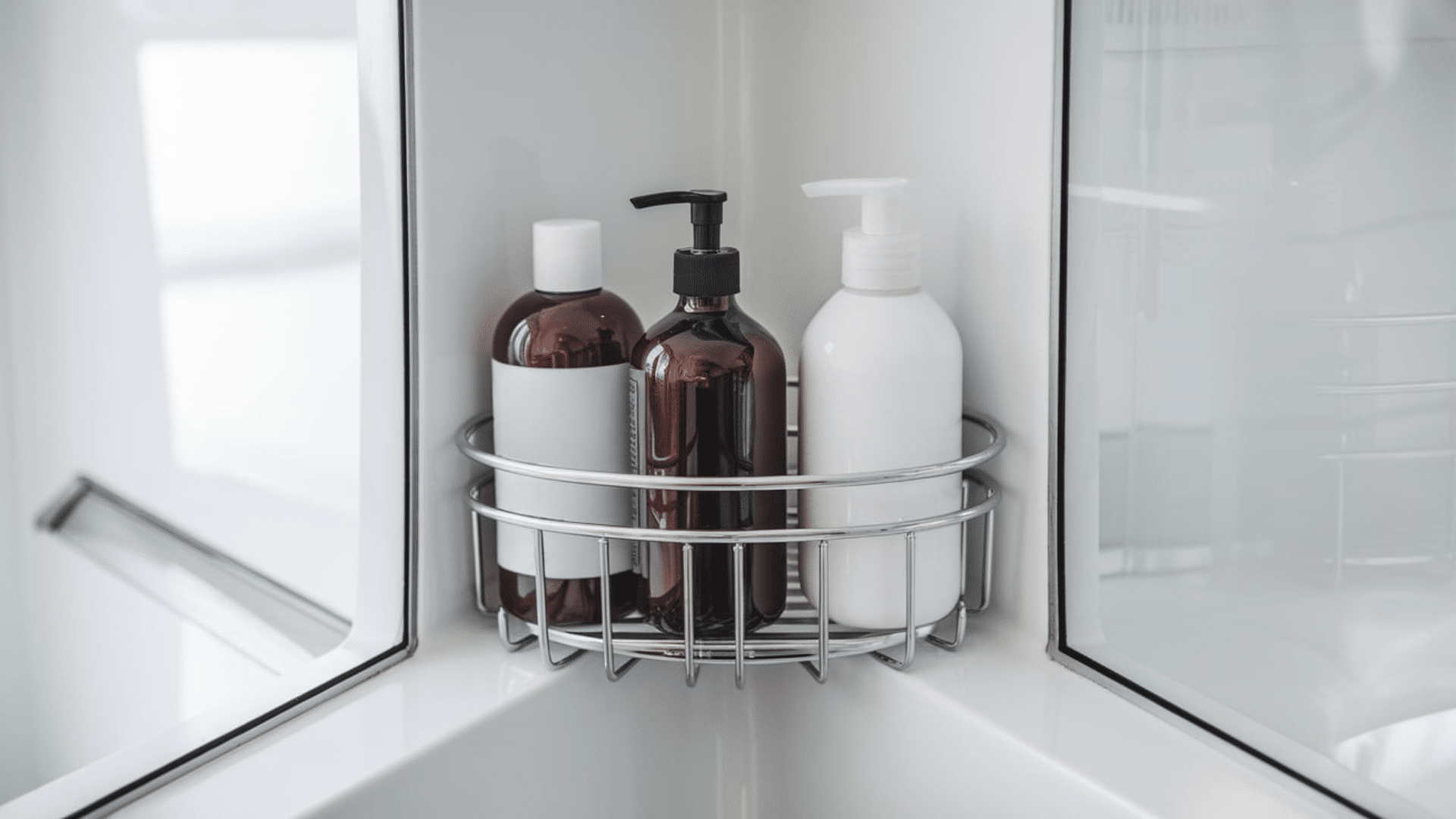
A shower caddy or corner shelf prevents bottles from piling on the tub edge. Pick one with adjustable shelves to fit different sizes of shampoos and soaps.
This not only saves space but also keeps everything within reach during showers.
27. Use a Slide-Out Under-Sink Drawer
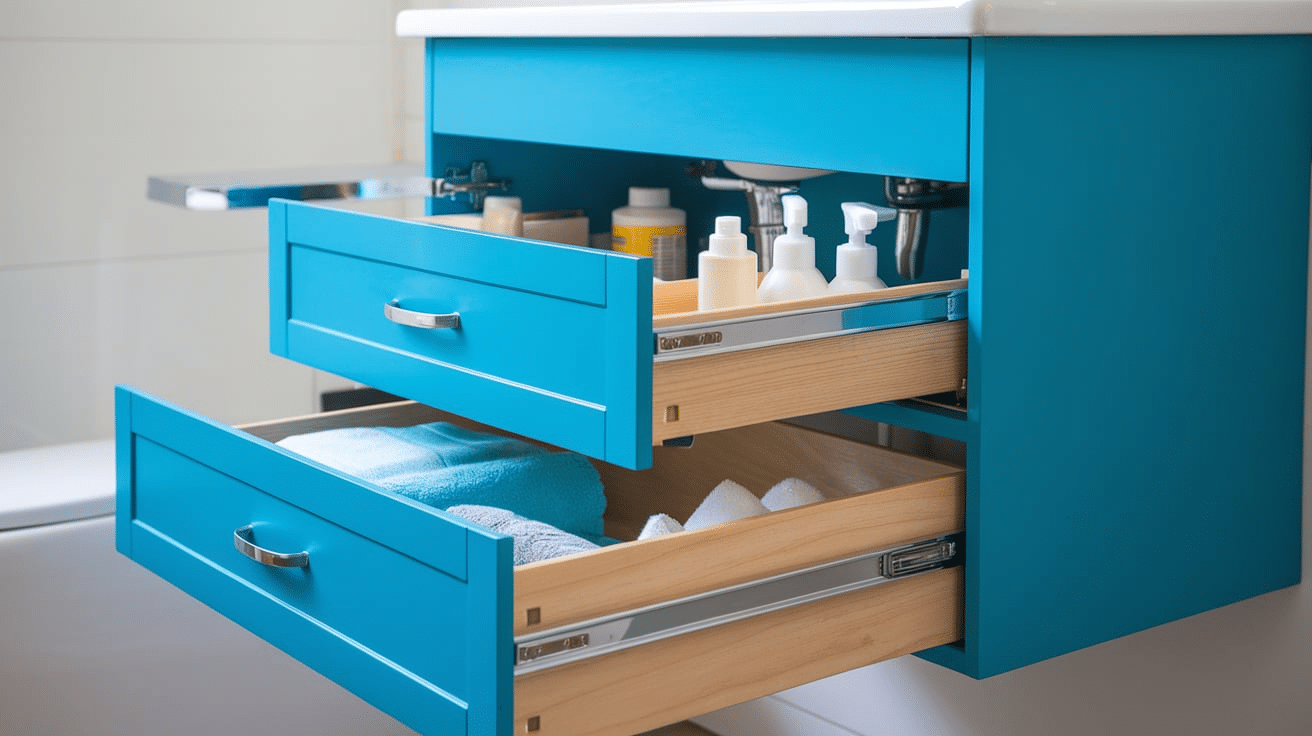
Instead of traditional bins, add a slide-out drawer system beneath your sink for backup supplies. It lets you access items easily without bending or digging through stacks.
This setup also keeps the area dry and tidy since the drawers glide smoothly on rails.
28. Add Wall-Mounted Bathroom Cabinets
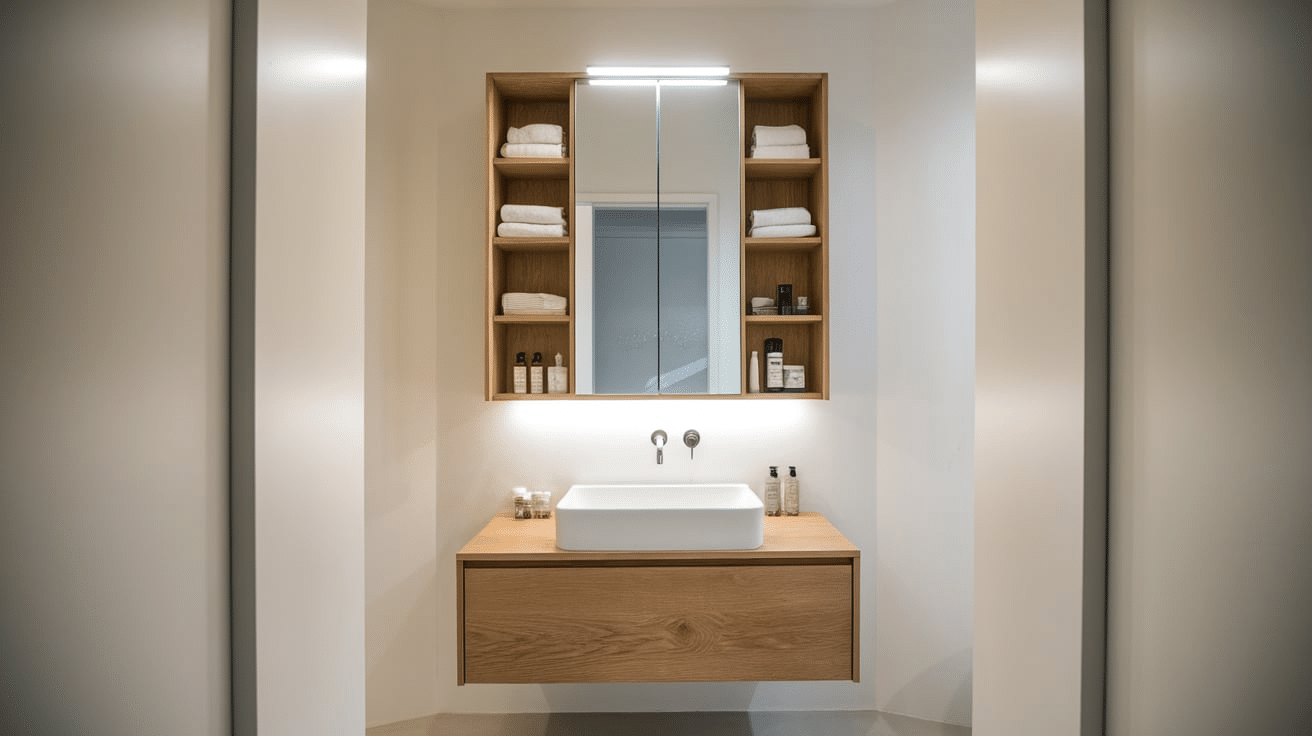
Install slim wall-mounted cabinets to make the most of vertical space in your bathroom. They’re perfect for storing extra toiletries, towels, and small essentials without crowding the countertop.
Choose mirrored or minimalist door designs to keep the space feeling open and modern.
Kids’ Room Organization
Kids’ rooms can go from neat to messy in minutes, but the right systems make cleanup faster and easier for everyone. These ideas focus on simple setups that children can actually maintain on their own.
29. Use Large Toy Bins
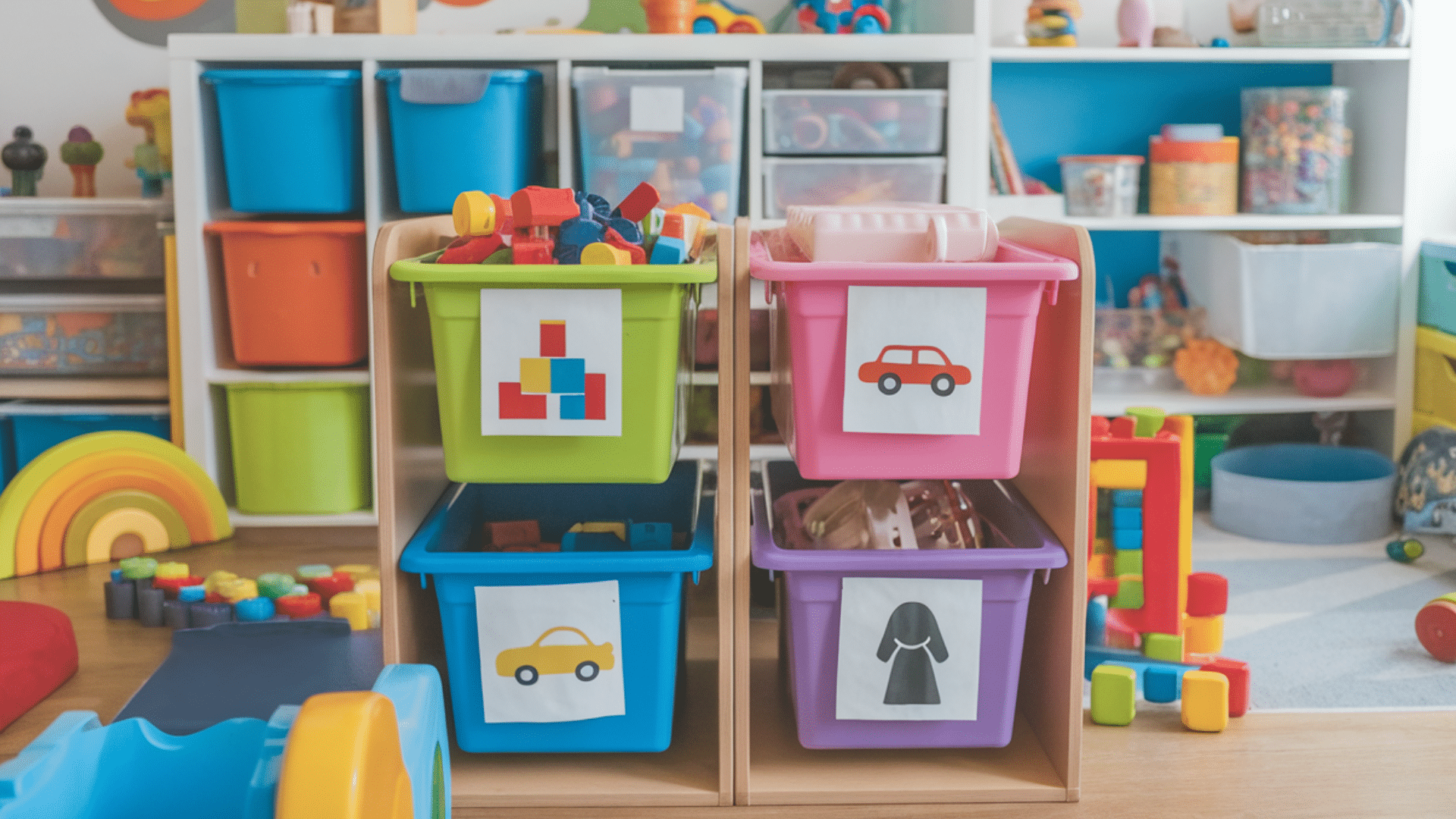
Instead of sorting toys into too many small categories, use a few large bins for broad groups like “blocks,” “cars,” or “dolls.”
Label them with pictures so kids know exactly where things belong. This makes cleanup quick and helps build good habits early on.
30. Create a Toy Rotation System
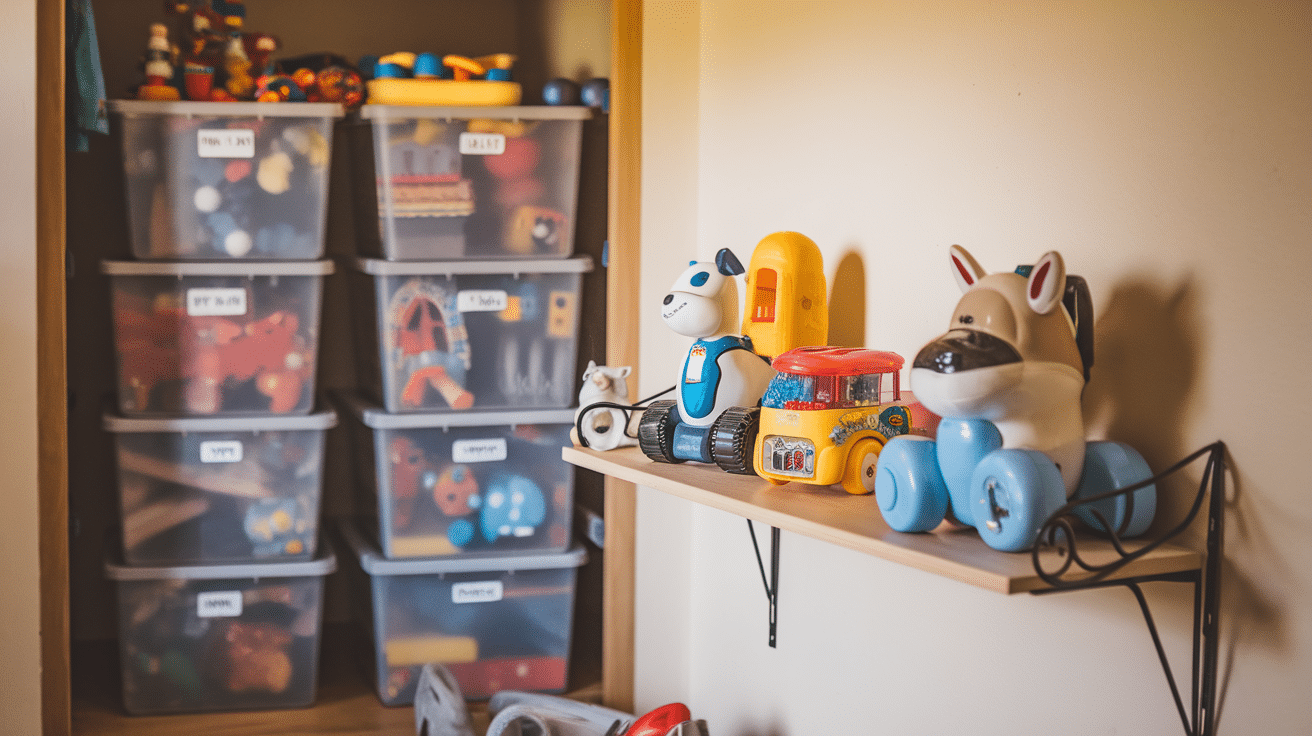
Keep only a few toys out at a time and store the rest in a separate bin. Rotate them every few weeks to keep playtime exciting and prevent overwhelm.
It also teaches kids to appreciate what they have without feeling buried in clutter.
31. Add Low Shelving Units
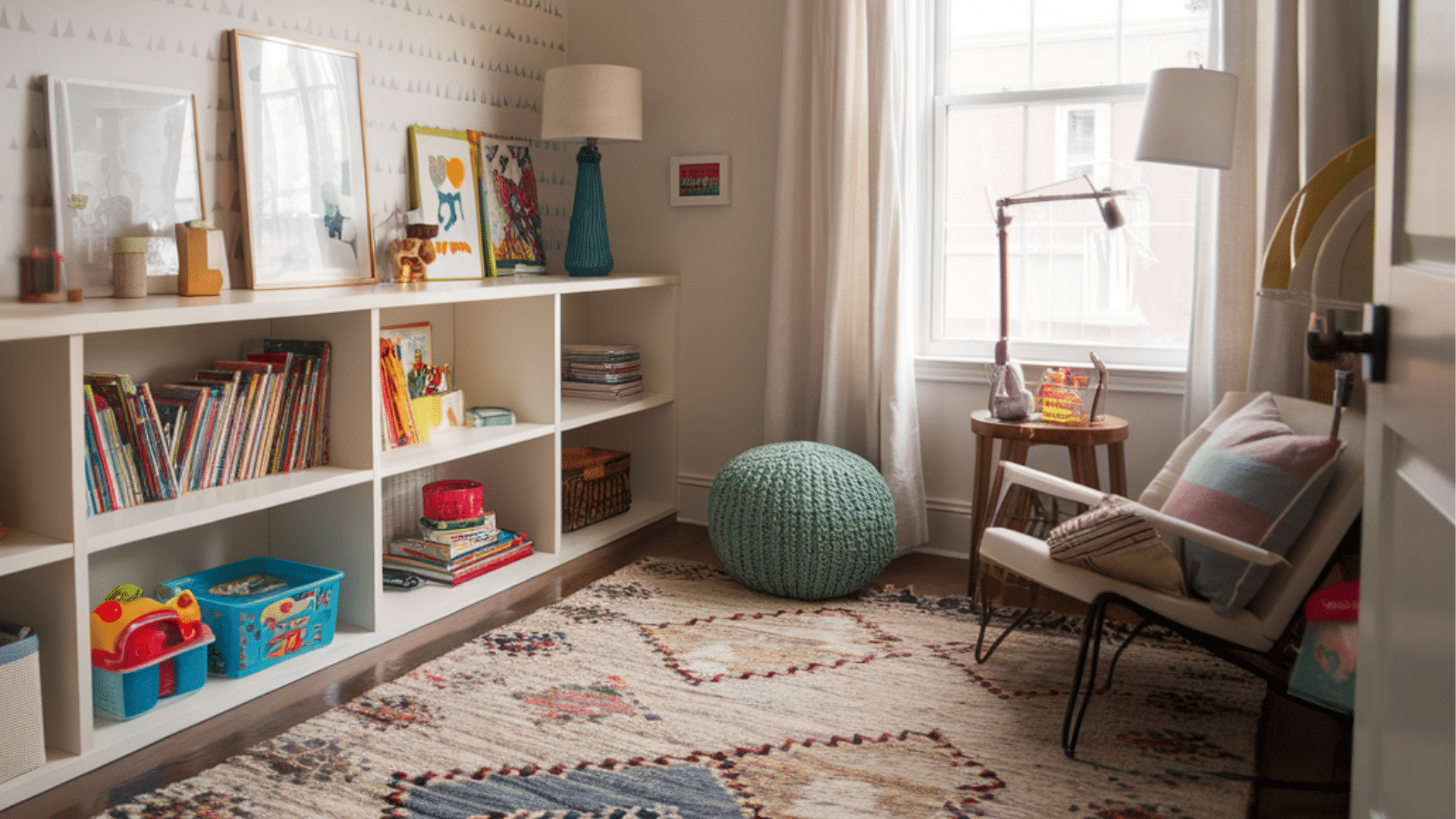
Low, open shelves make it easier for kids to reach and put away their own things. Use small baskets or boxes to group items like books, puzzles, or art supplies.
Keeping storage at their level gives them a sense of responsibility and independence.
32. Set Up a Homework Station
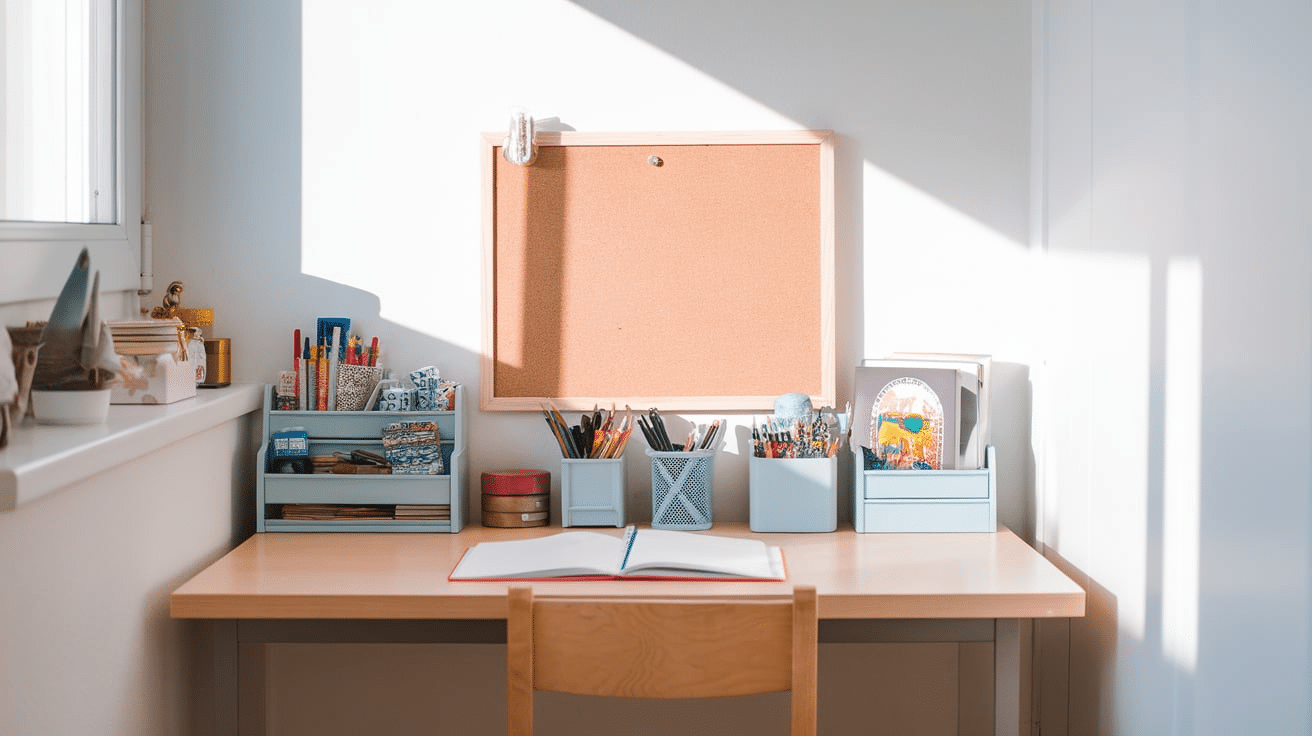
Create a small desk or corner where school supplies stay organized and ready to use. Add pencil holders, paper trays, and a corkboard for reminders or artwork.
A clean workspace helps kids focus better and builds simple routines.
33. Add a Reading Nook Corner
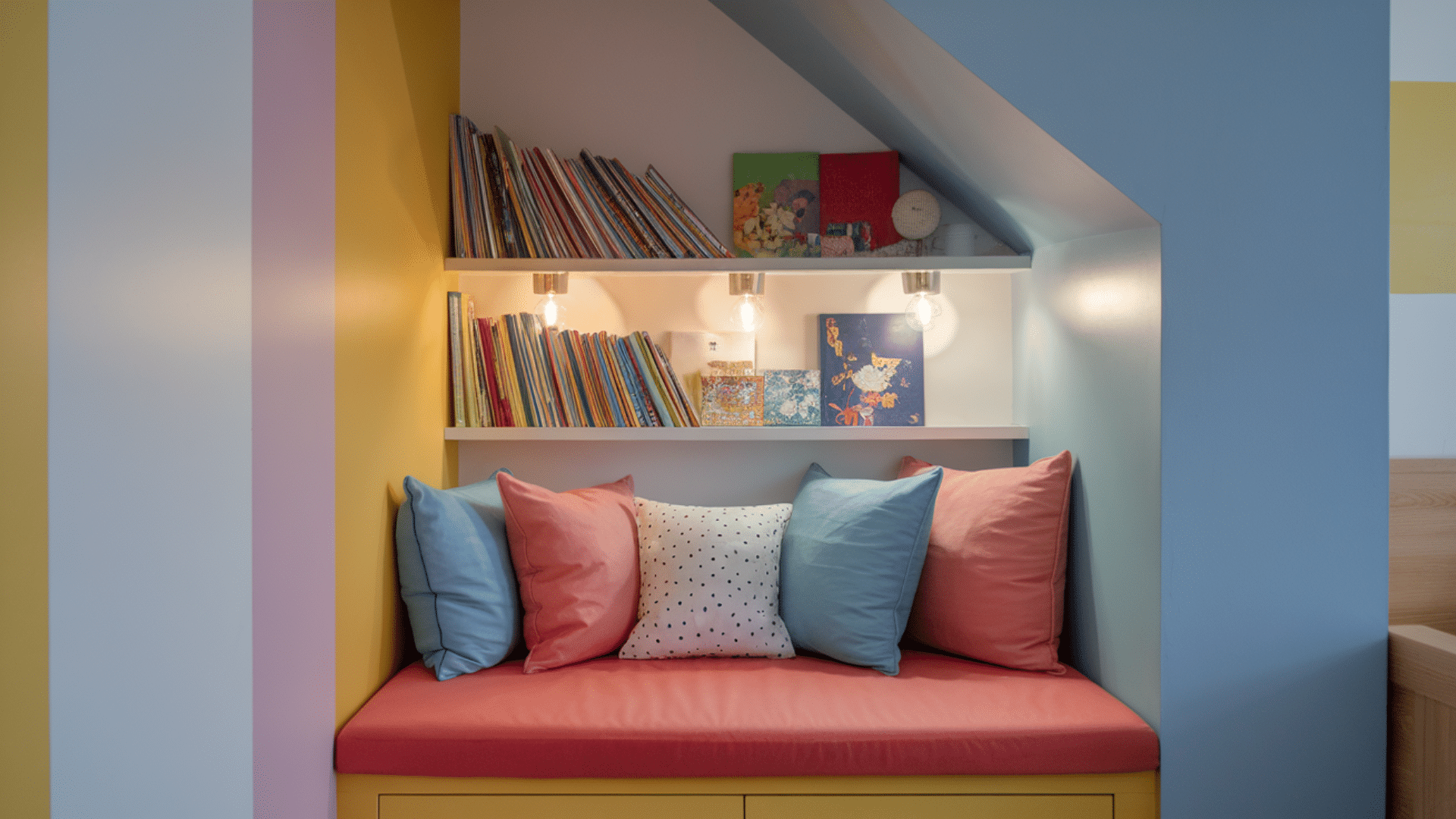
Create a cozy reading nook with a small bookshelf, soft cushions, and good lighting. It gives kids a quiet place to relax while keeping books organized and off the floor.
You can rotate books regularly to keep them excited about reading and make cleanup part of their routine.
34. Add a Toy Display Shelf
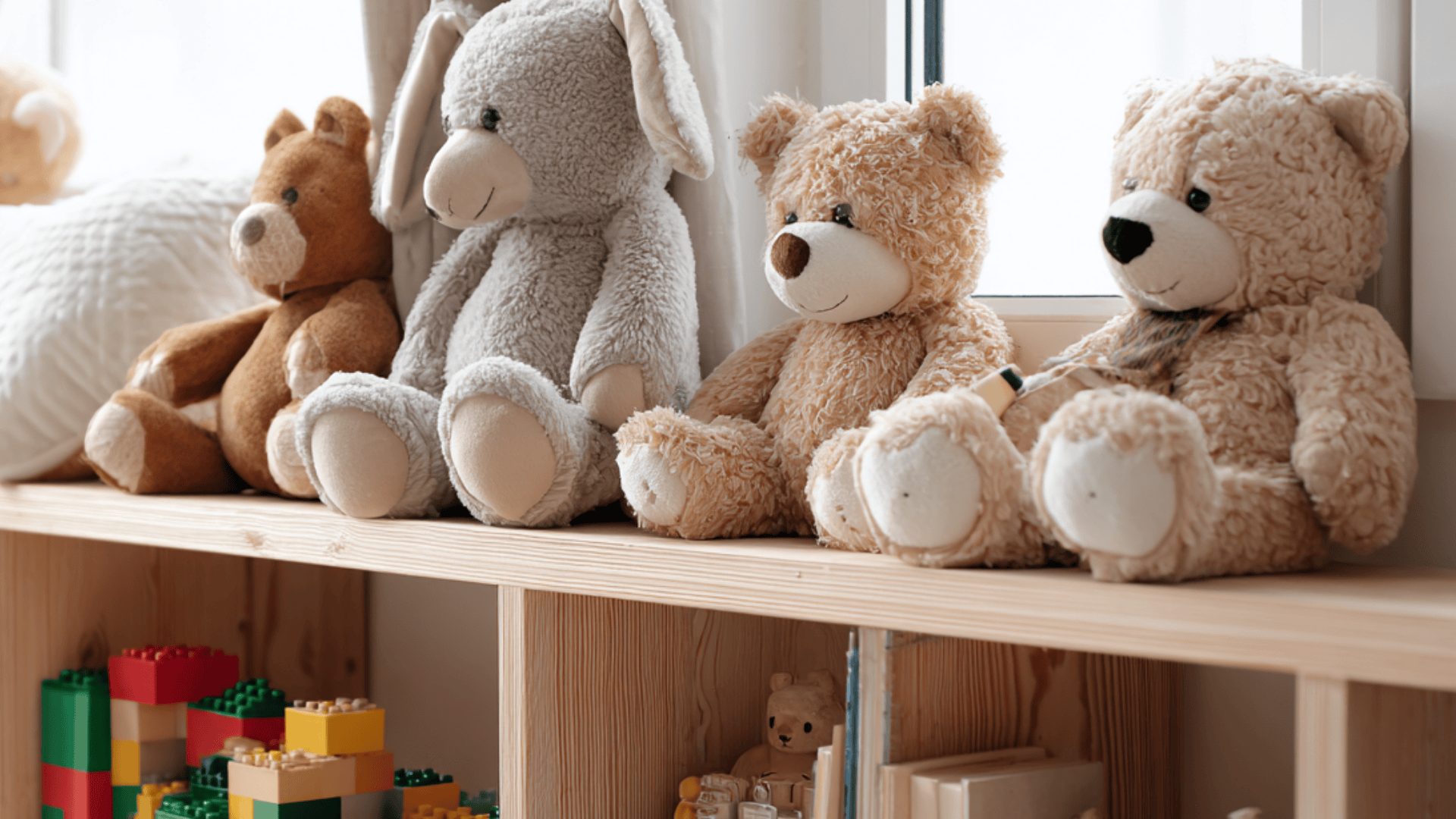
Instead of hiding every toy, set up a low display shelf for favorite items like figurines, stuffed animals, or LEGO creations.
It keeps special toys visible while teaching kids to take care of what they display. Rotating the items often also helps reduce clutter and keeps the room feeling new.
35. Add a Bedside Organizer Pocket
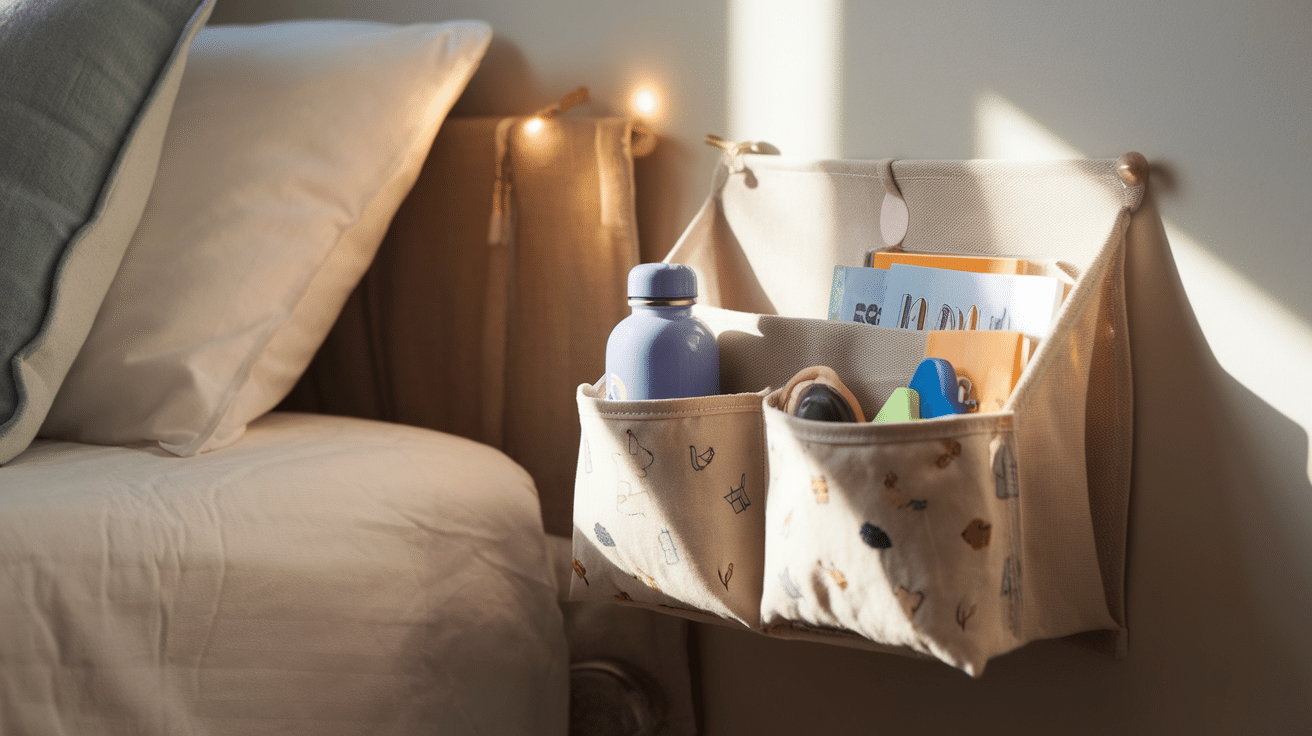
Attach a fabric bedside organizer to hold bedtime essentials like books, a flashlight, or a water bottle. It keeps items off the floor and within easy reach.
This little storage trick helps kids stay organized and makes bedtime routines calmer and more independent.
Home Office Organization
A well-organized home office helps you stay focused, productive, and less stressed. The goal is to keep only what you need within reach and give every item a specific place.
36. Use Drawer Organizers for Supplies
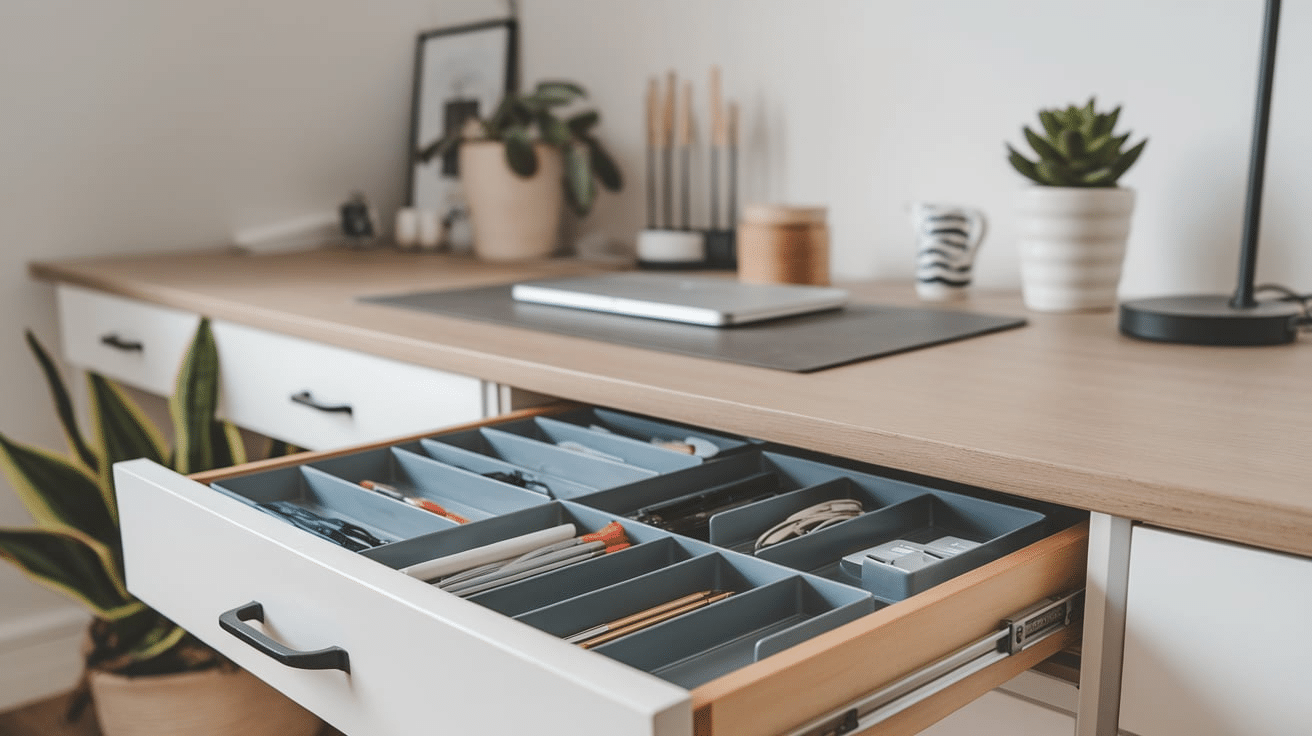
Desk drawers can get messy fast with pens, clips, and cables. Drawer organizers separate each item so you can find what you need quickly.
Try shallow trays or adjustable inserts that fit snugly – this keeps your workspace clutter-free and efficient.
37. Create a Paper Management System
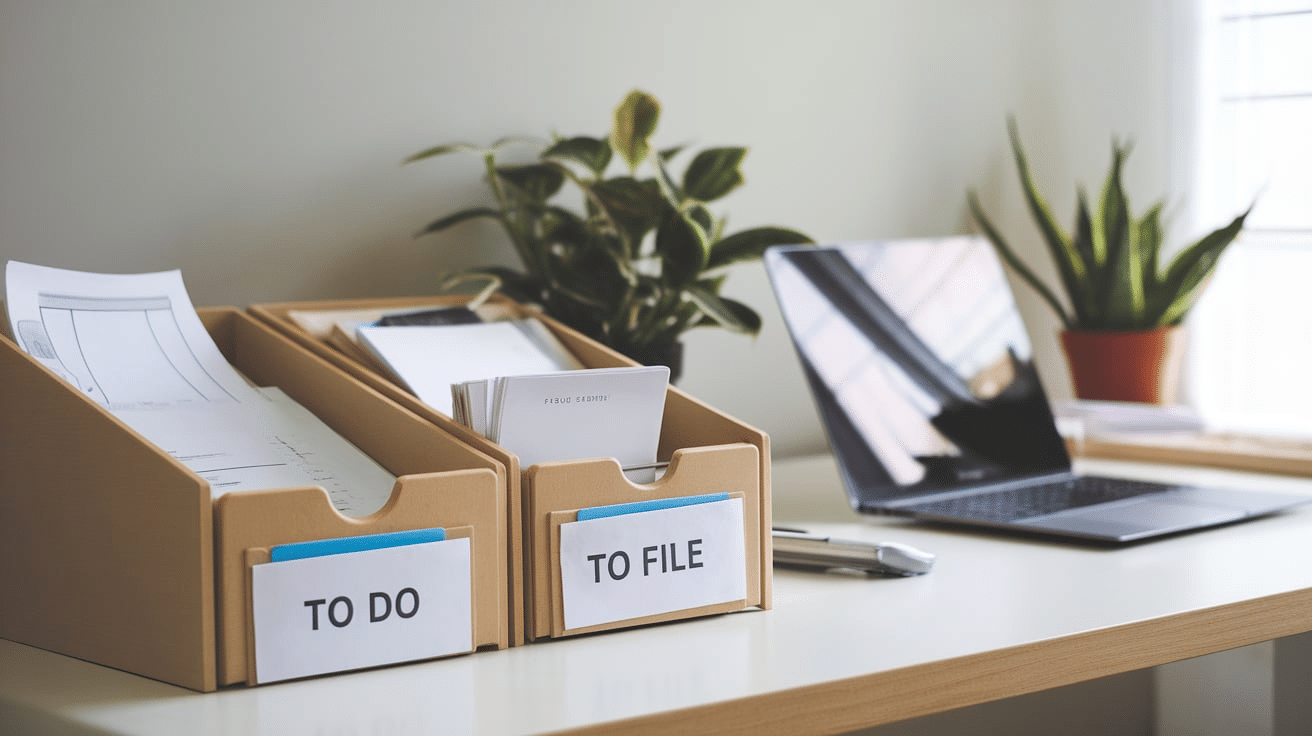
Paper clutter builds up easily, so use file folders or trays labeled “To Do,” “To File,” and “To Shred.” Review them weekly to keep piles from growing.
Going digital for bills and notes can also help reduce unnecessary paper.
38. Hide Cables with a Cord Organizer
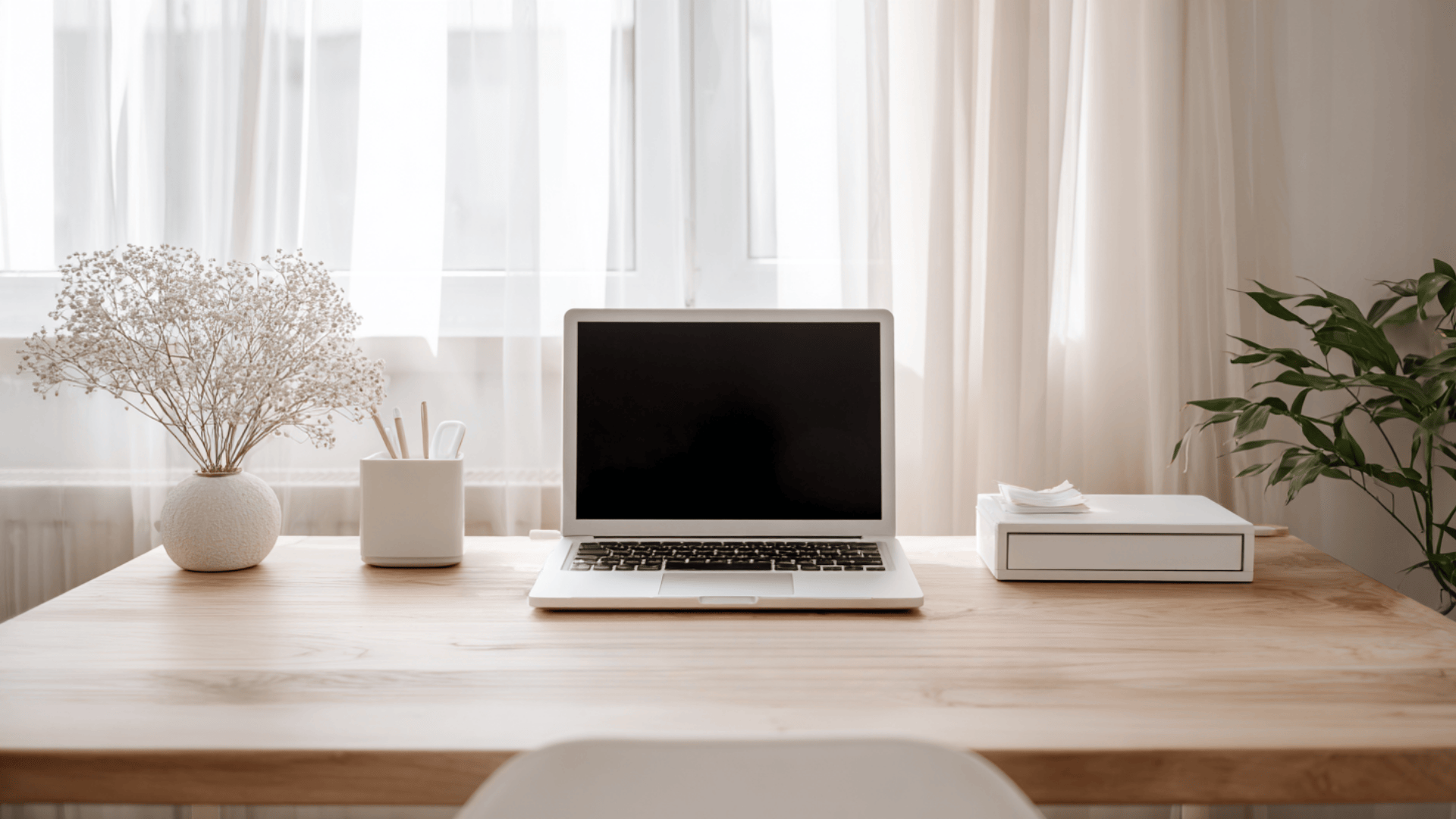
Tangled cords can make even a clean desk look messy. Use cable clips, sleeves, or boxes to hide wires behind or under your desk.
Label each plug so you know which device it belongs to when you need to unplug something.
39. Use Vertical Storage
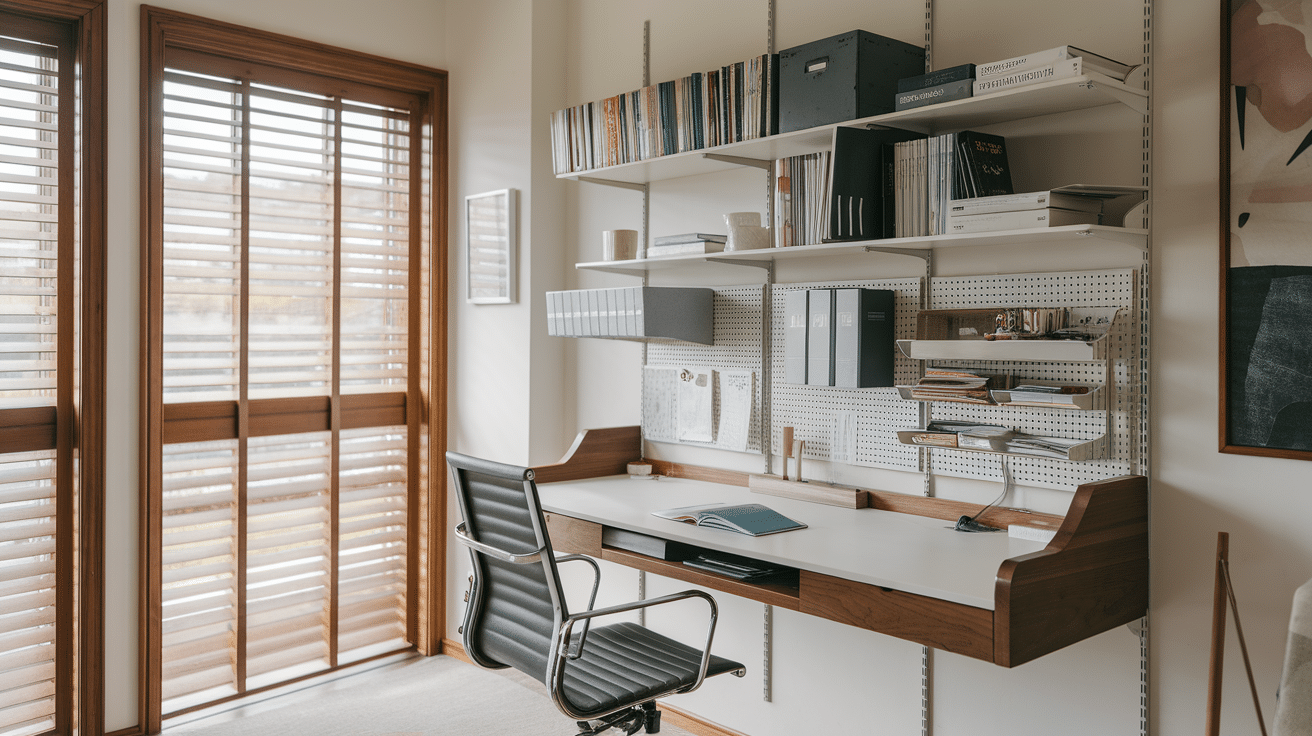
Install shelves or a pegboard above your desk for books, files, and office supplies. This keeps your desk surface clear and gives you more room to work.
Pegboards are especially great for hanging tools like scissors, chargers, or headphones.
40. Keep a Minimal Desktop

Only keep essentials, like your laptop, notebook, and a few pens, on the surface.
Use drawers or baskets to store everything else out of sight. A clean desk helps you focus better and makes it easier to reset at the end of the day.
41. Designate a Charging Station
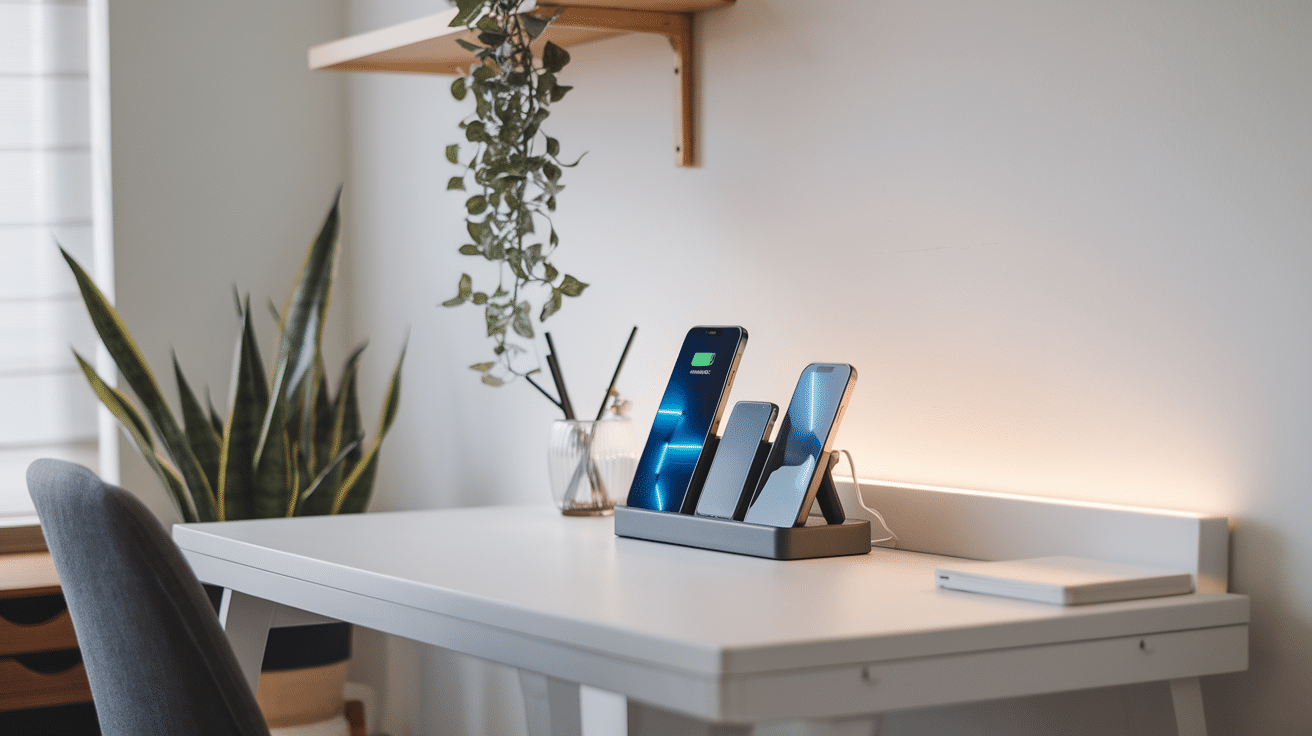
Keep all your devices in one place using a multi-port charger or a small docking tray. It prevents cords from spreading across the desk and keeps your tech organized.
Having a single spot for charging also reduces the chance of misplaced gadgets.
42. Add a Bulletin or Whiteboard
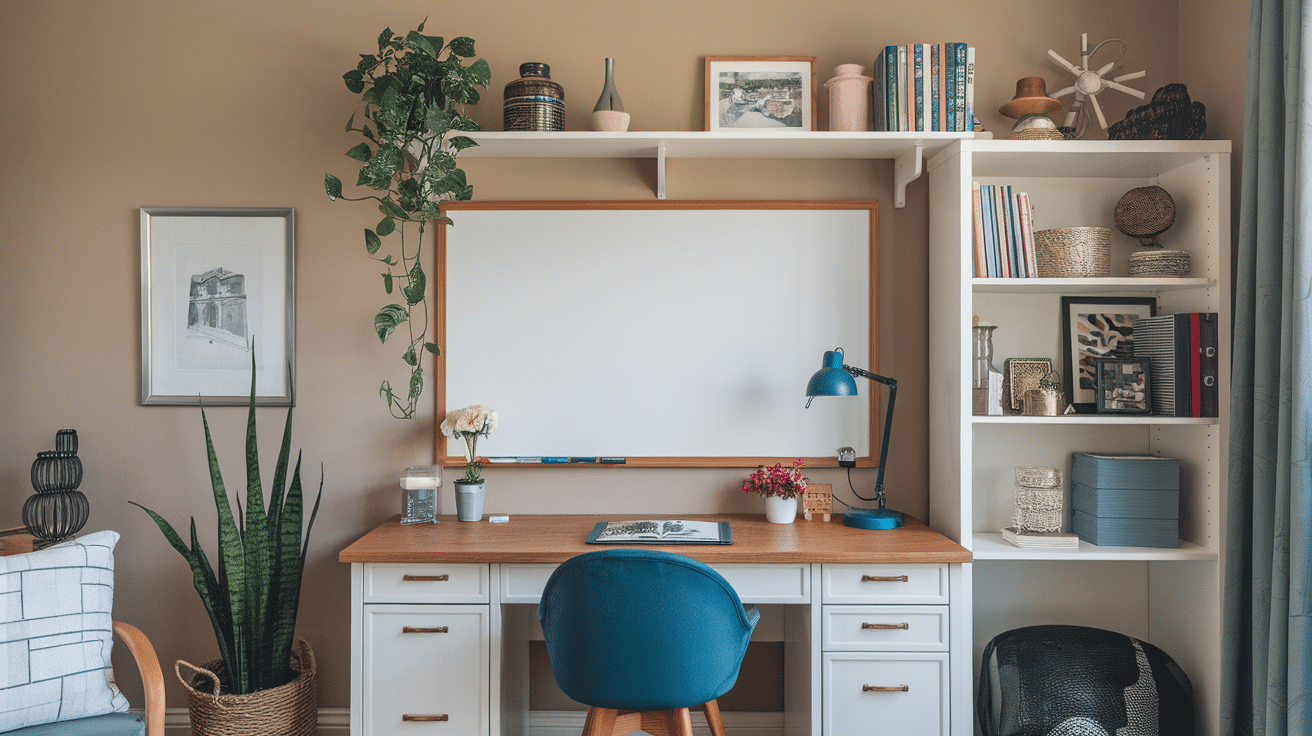
A small board helps you keep track of tasks, reminders, and deadlines without stacks of sticky notes.
You can also use it for motivational quotes or weekly goals. Keeping your plans visible helps you stay on top of things without feeling overwhelmed.
Laundry Room Organization
The laundry room is one of those spaces that works hard but often gets overlooked. With the right setup, it can run smoothly and stay neat – even on busy days.
43. Use Separate Hampers for Sorting
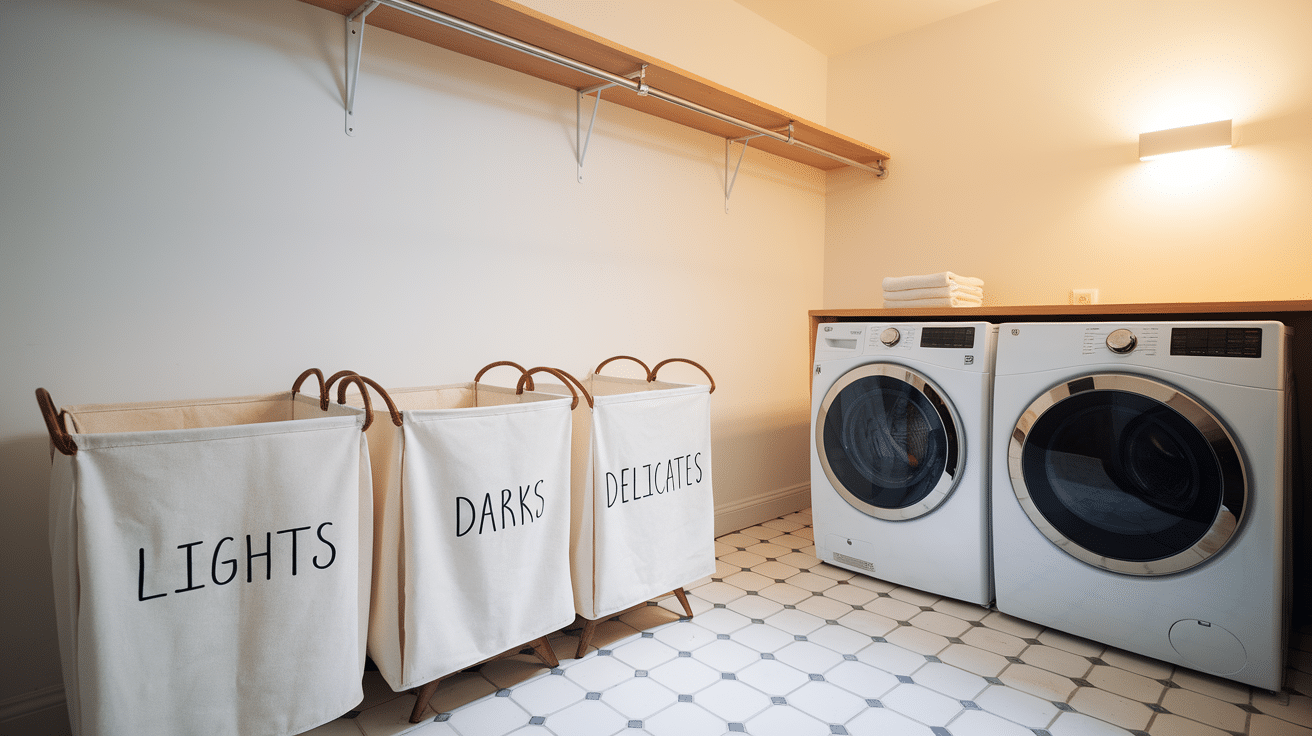
Keep multiple hampers labeled “Lights,” “Darks,” and “Delicates.” Sorting as you go saves time on laundry day and prevents piles from taking over the floor. It’s a simple system that makes the process more efficient for the whole family.
You can even add small labels or icons for kids to learn how to sort their clothes correctly from an early age.
44. Add Wall-Mounted Drying Racks
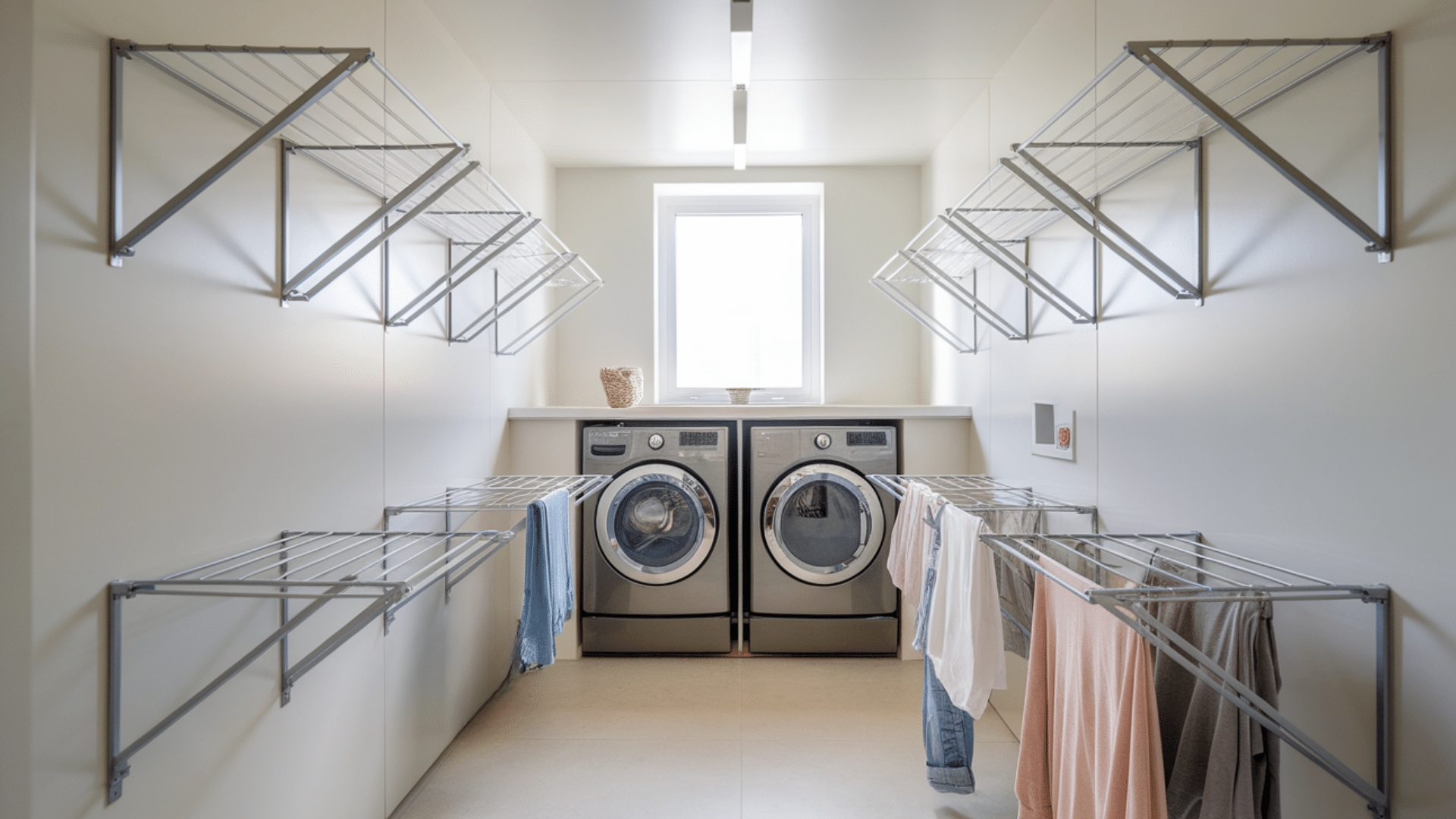
Foldable or pull-down drying racks free up floor space and are perfect for air-drying clothes. Mount them above the washer or near a window for better airflow. When not in use, fold them flat to keep the area uncluttered.
This setup keeps delicate clothes in good shape and saves energy by reducing your reliance on the dryer.
45. Install a Hanging Rod for Air Drying
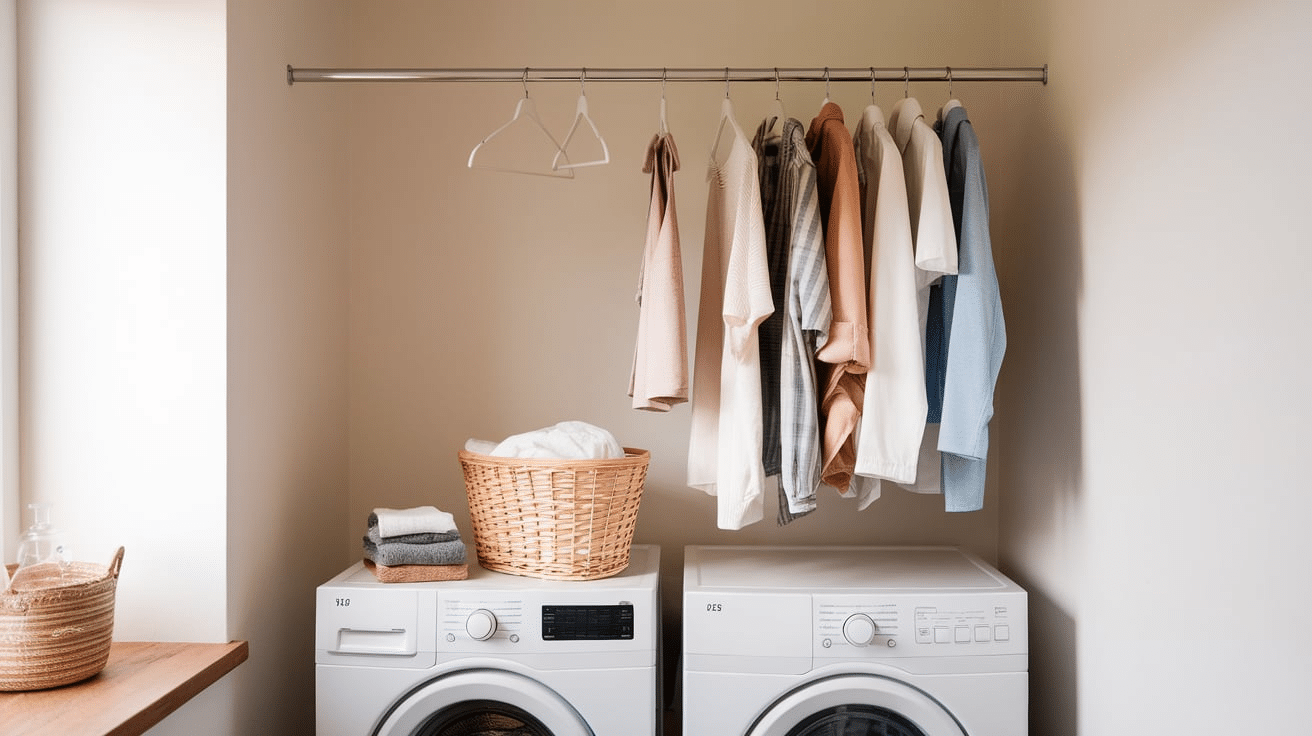
Mount a simple rod or tension bar above the washer and dryer to hang clothes that need to air dry. It prevents wrinkles and keeps damp clothes from ending up on furniture. Add hangers to make drying quick and neat.
You can also use it to hang freshly ironed clothes, keeping them wrinkle-free until they’re ready to be put away.
46. Add a Wall-Mounted Cabinet Organizer
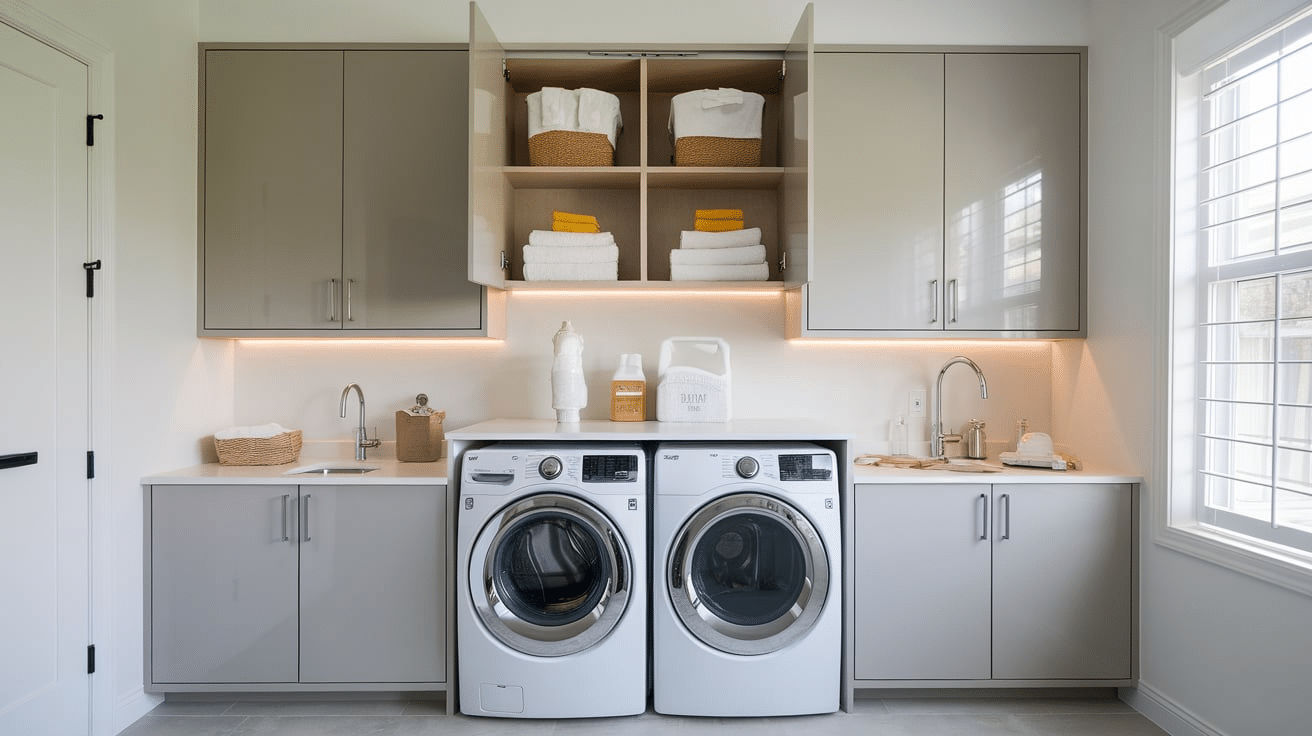
Install a shallow wall cabinet above your washer and dryer to store detergents, fabric softeners, and cleaning supplies.
Closed doors keep visual clutter hidden and make your laundry room feel cleaner. Choose one with adjustable shelves so you can customize the space for bottles or folded towels.
47. Add a Folding Station
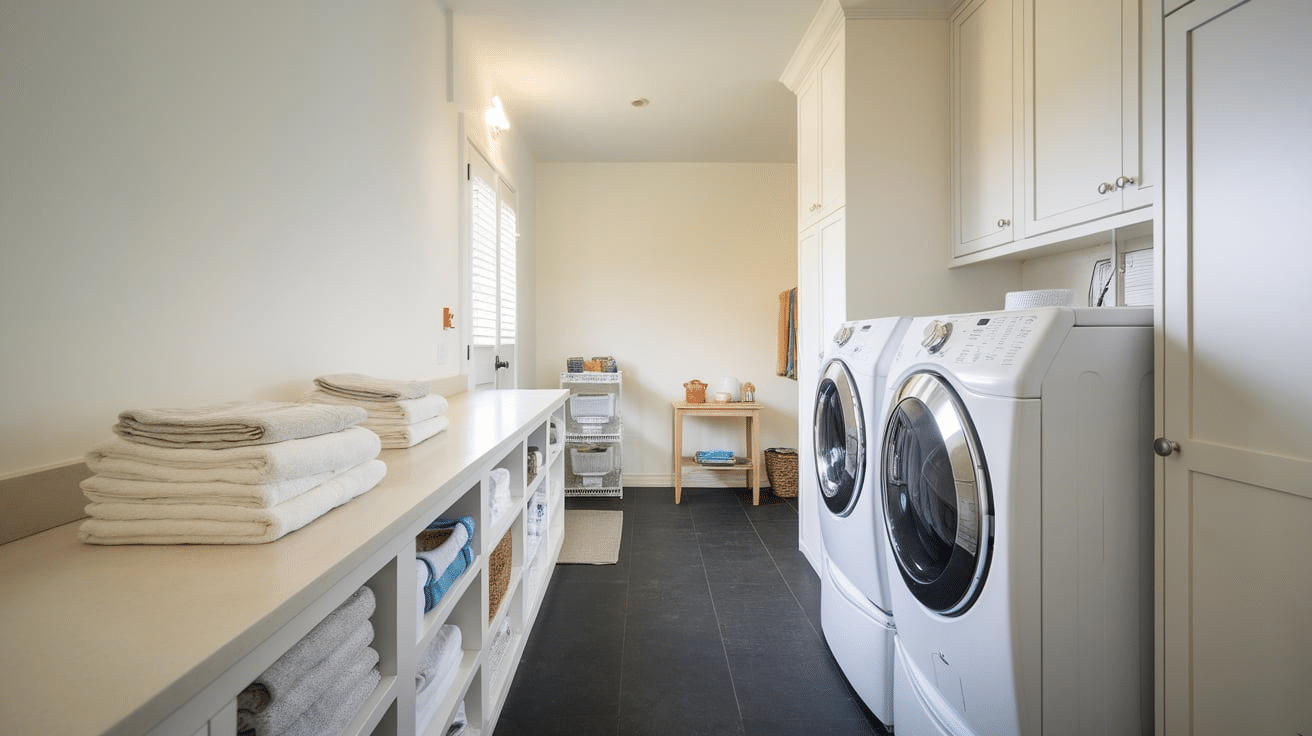
If space allows, set up a counter or small table for folding clothes right away. Keeping this task contained in one spot prevents clean laundry from ending up in piles elsewhere.
Choose a surface that’s easy to wipe clean and wide enough for towels or linens.
48. Use Rolling Carts for Flexibility
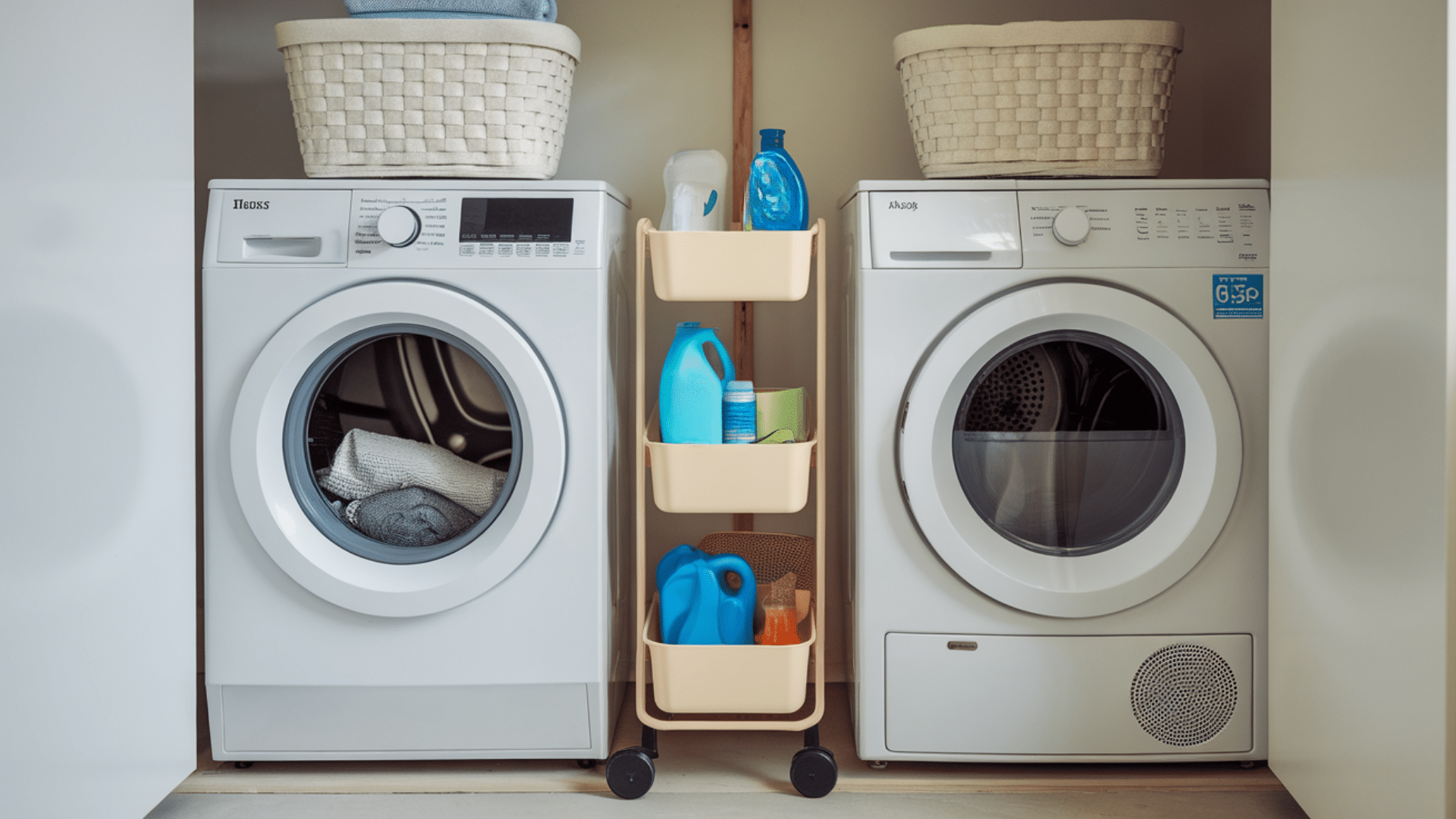
A slim rolling cart fits between appliances or in tight corners and can hold supplies or small baskets. You can move it around as needed and slide it out of sight when not in use. It’s a great solution for compact laundry areas.
Try grouping items by use, like detergents, stain removers, and cleaning sprays, so everything stays organized and easy to grab.
49. Install a Slat Wall System
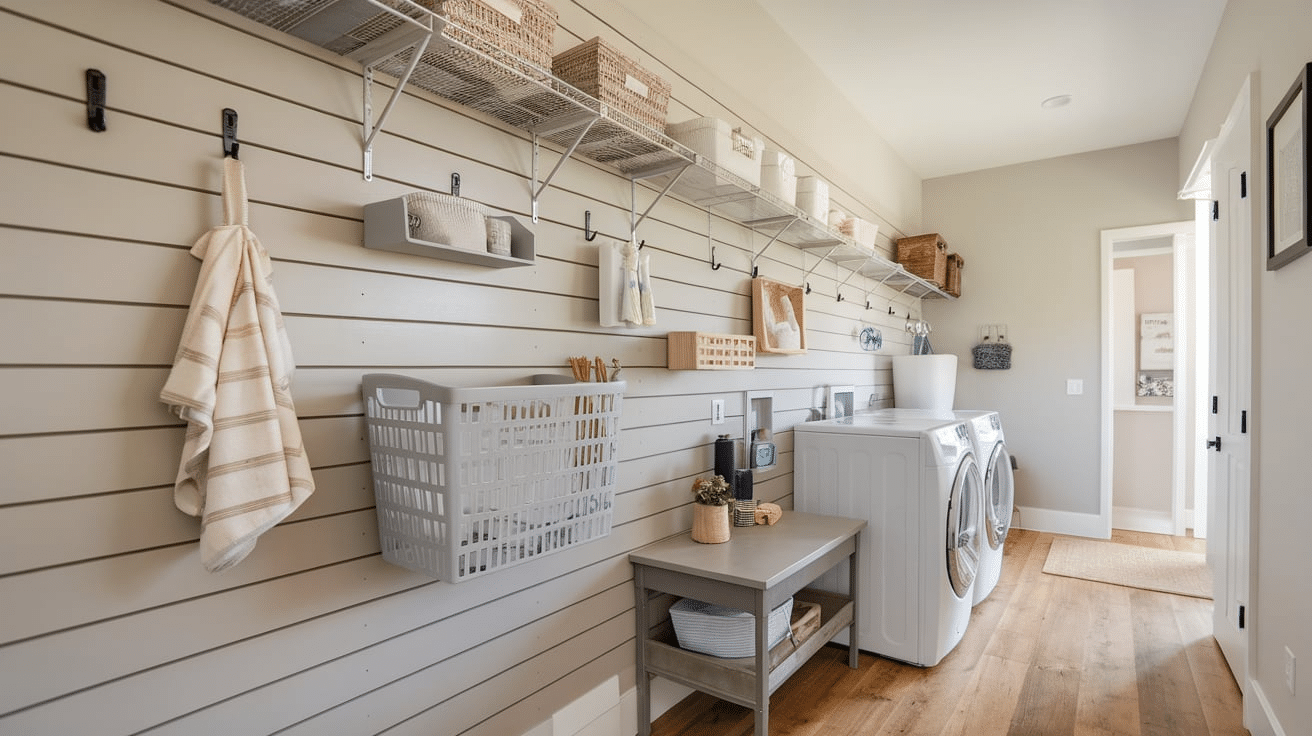
A slat wall system gives you flexible, adjustable storage for all your laundry essentials. You can hang baskets, hooks, and small shelves on the panels, making it easy to rearrange as your needs change.
It looks clean, holds more weight than a pegboard, and adds a modern touch.
Garage, Entry Closet & “Drop Zones” Organization
The garage, entry closet, and drop zones often collect random items that don’t seem to belong anywhere else. With a few smart systems, you can turn these messy spots into practical, easy-to-use spaces that stay organized all year long.
50. Add Wall-Mounted Shelving
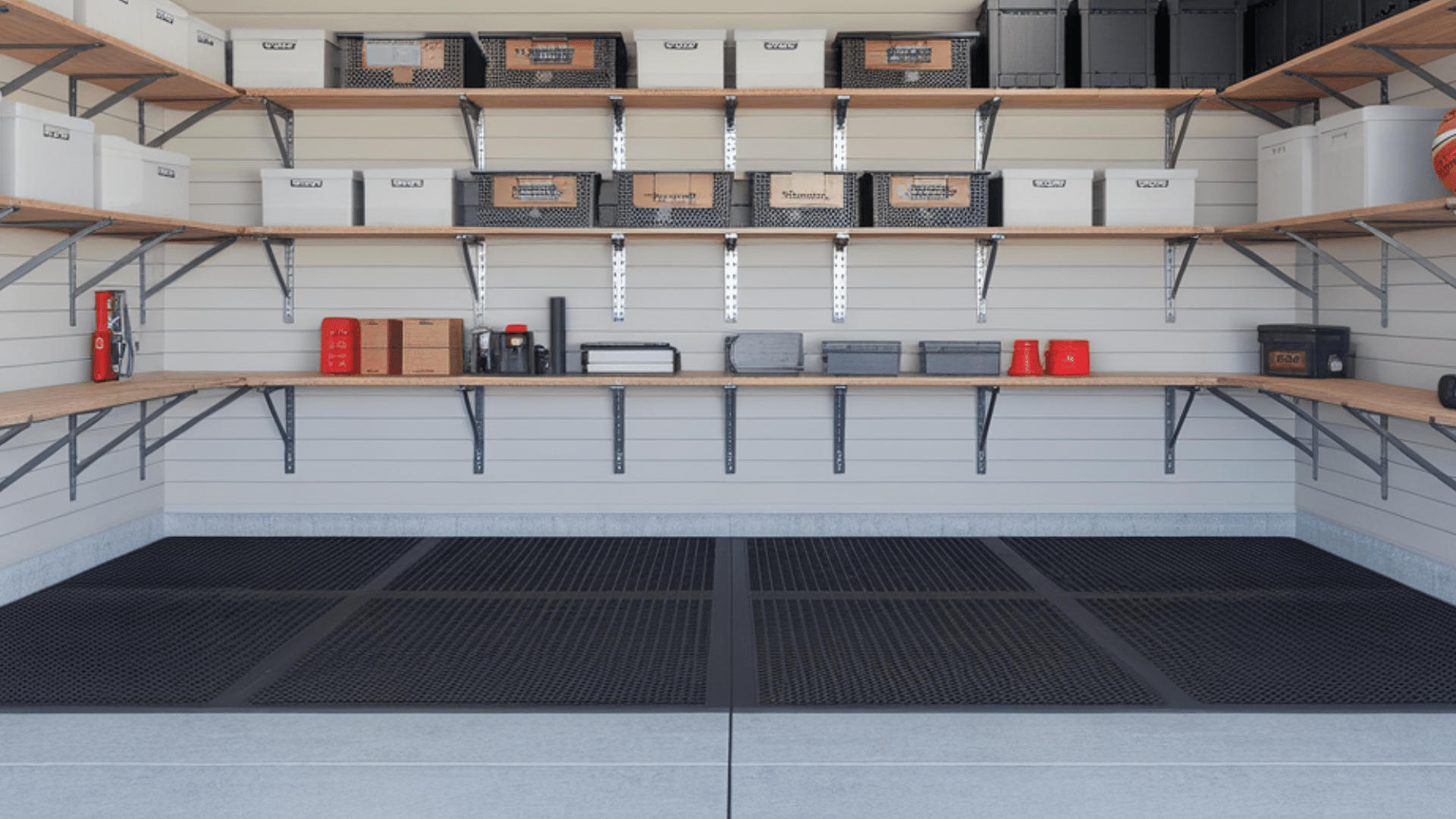
Use sturdy metal or wood shelves to store boxes, tools, and seasonal gear off the floor. Label each shelf by category, like “camping,” “sports,” or “cleaning”, to make things easier to find.
This setup also keeps the garage cleaner and more open for parking.
51. Add a Tool Storage Cabinet
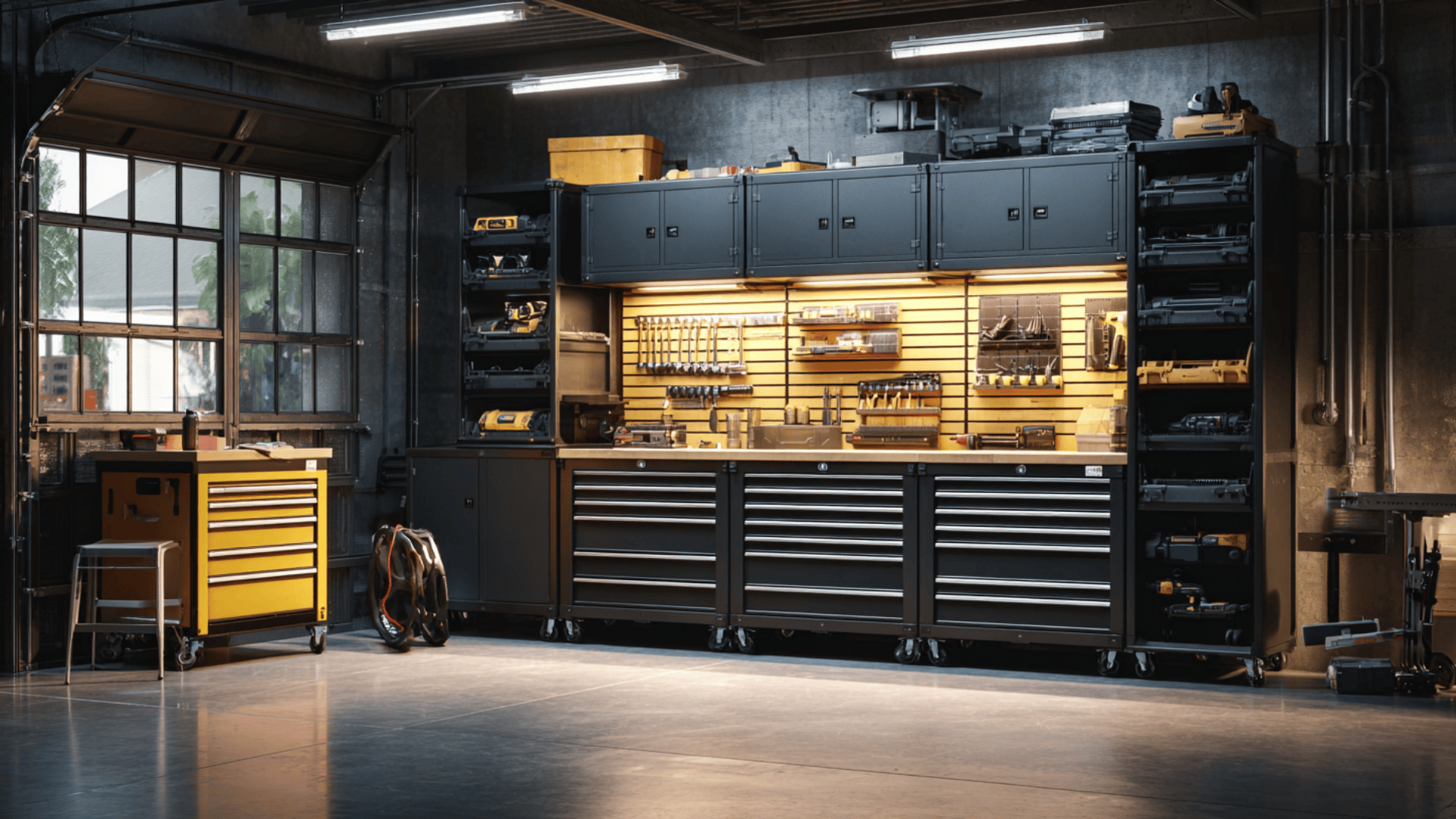
Replace open shelving with a lockable tool storage cabinet to keep sharp or valuable tools safely stored.
Choose one with drawers for smaller items and deep compartments for larger equipment. It keeps the garage looking tidy and adds an extra layer of safety and organization.
52. Install a Pegboard for Tools
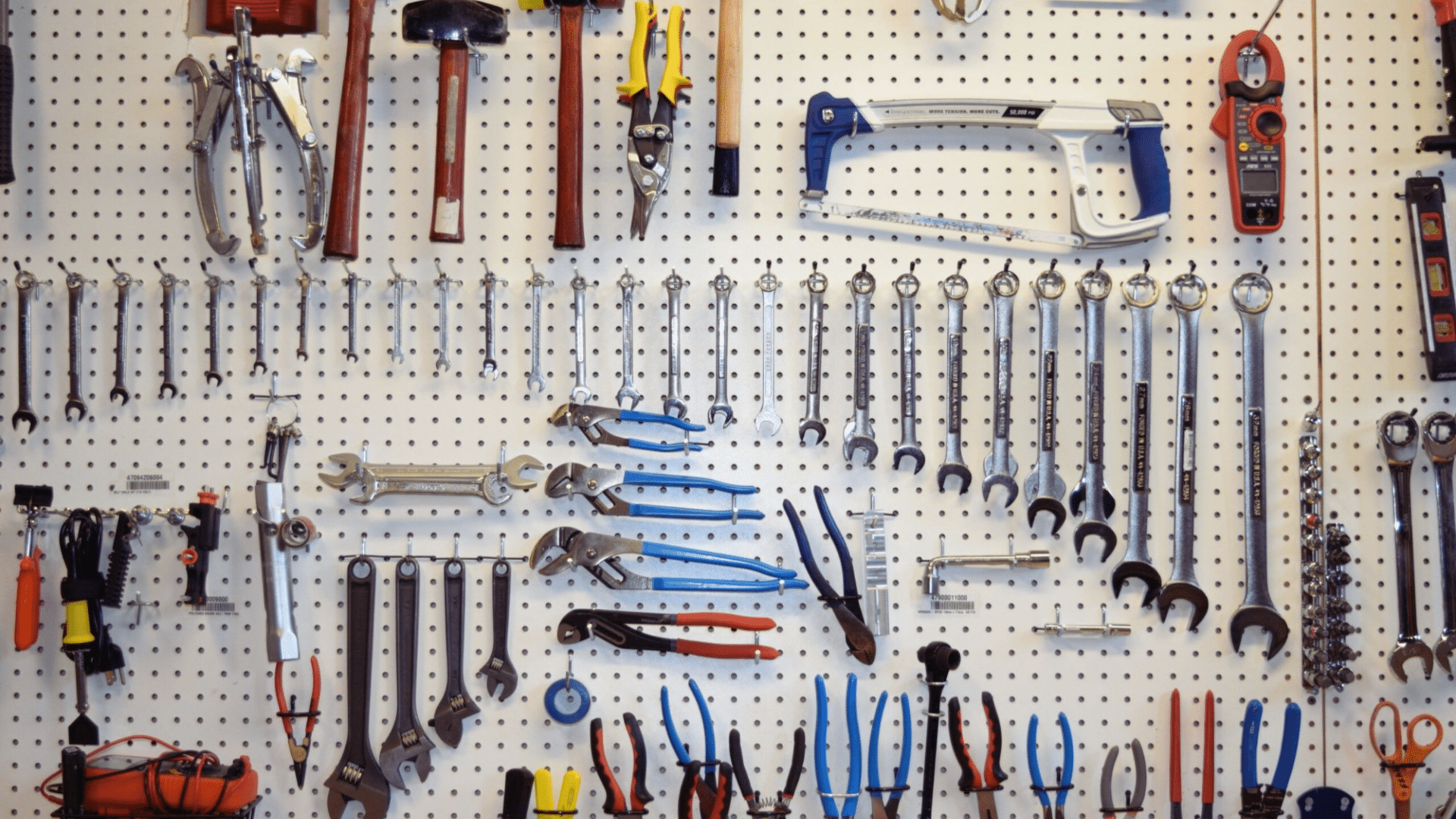
Pegboards work wonders for hanging tools, extension cords, or gardening gear. Arrange items by size or task so everything has a specific spot. It’s a visual system that saves time and keeps tools from piling up on workbenches.
You can even outline each tool on the board so every piece has a clear “home” after use.
53. Add Pull-Out Shoe Drawers
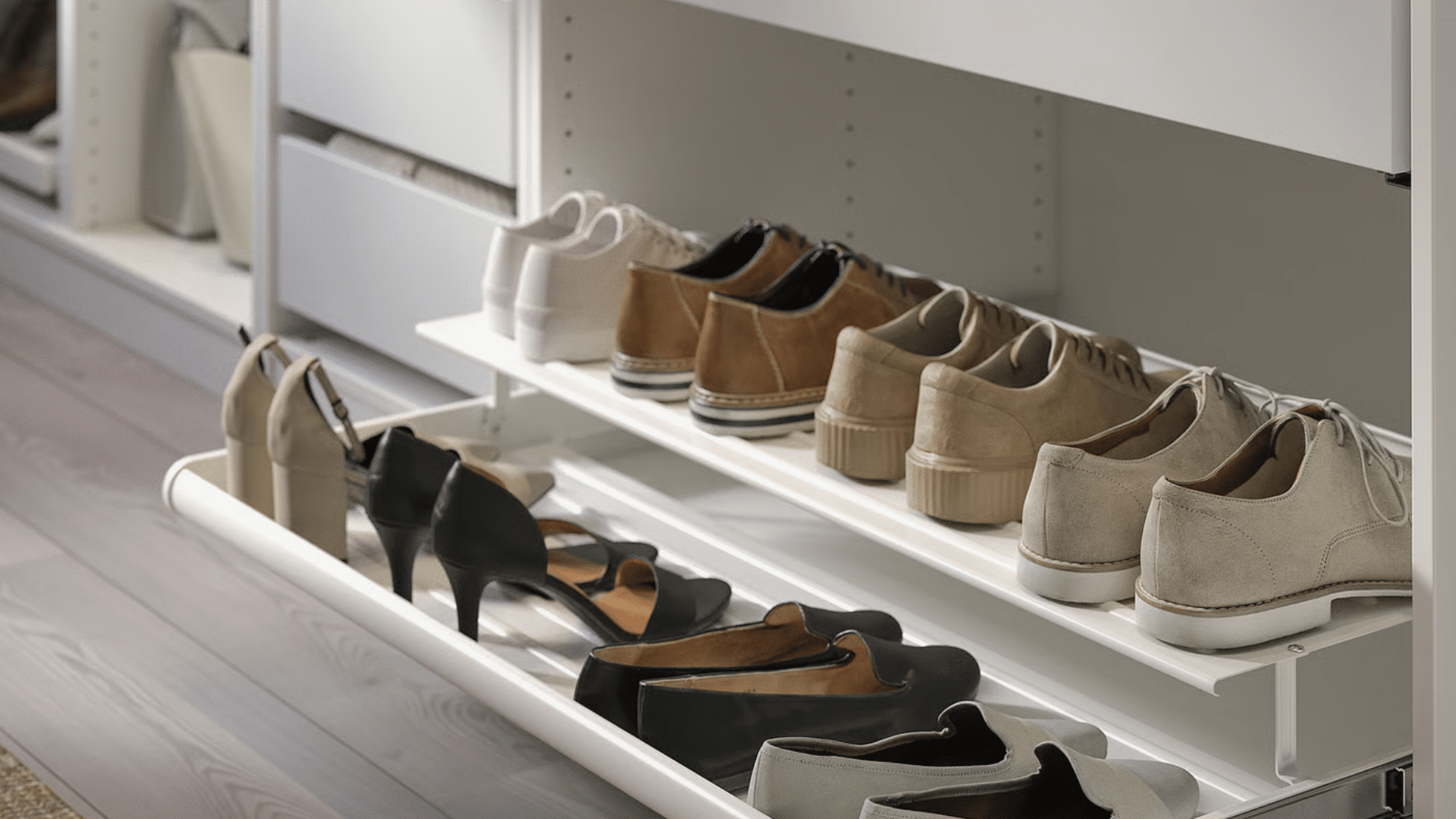
Instead of open baskets, install shallow pull-out drawers or bins for shoes. They keep pairs contained and prevent piles on the closet floor
Labeling isn’t needed – each family member can have their own drawer for quick grab-and-go use. Choose drawers with ventilation holes to keep shoes fresh and prevent unwanted odors.
54. Hang Vertical Bike Racks
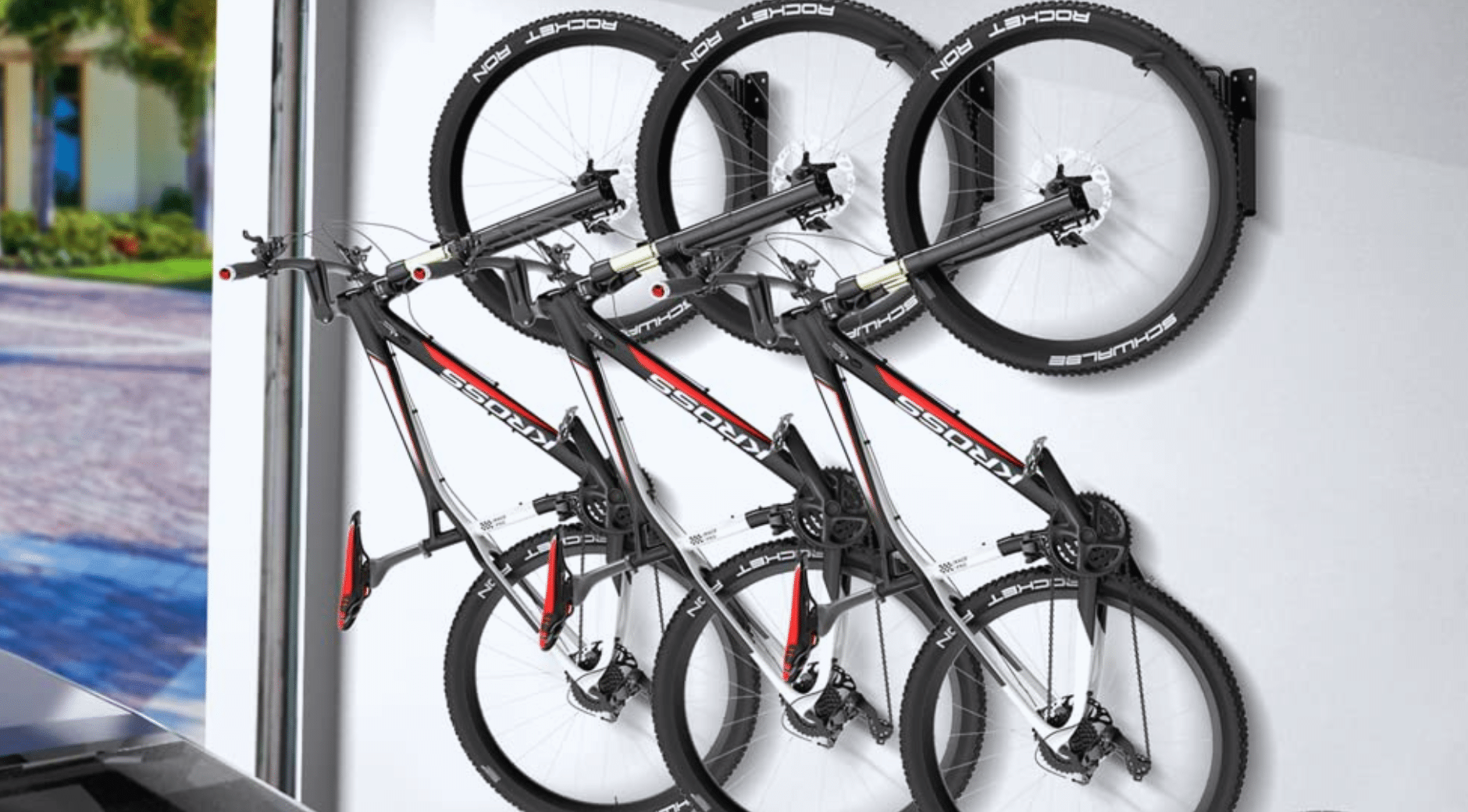
If your garage doubles as storage, wall-mounted or ceiling bike racks free up tons of floor space. They also protect bikes from damage and make it easy to grab one when you’re heading out.
For extra stability, use padded hooks to protect bike frames and prevent scratches. It’s a great investment for families or active households.
55. Create a Ceiling-Mounted Storage Rack
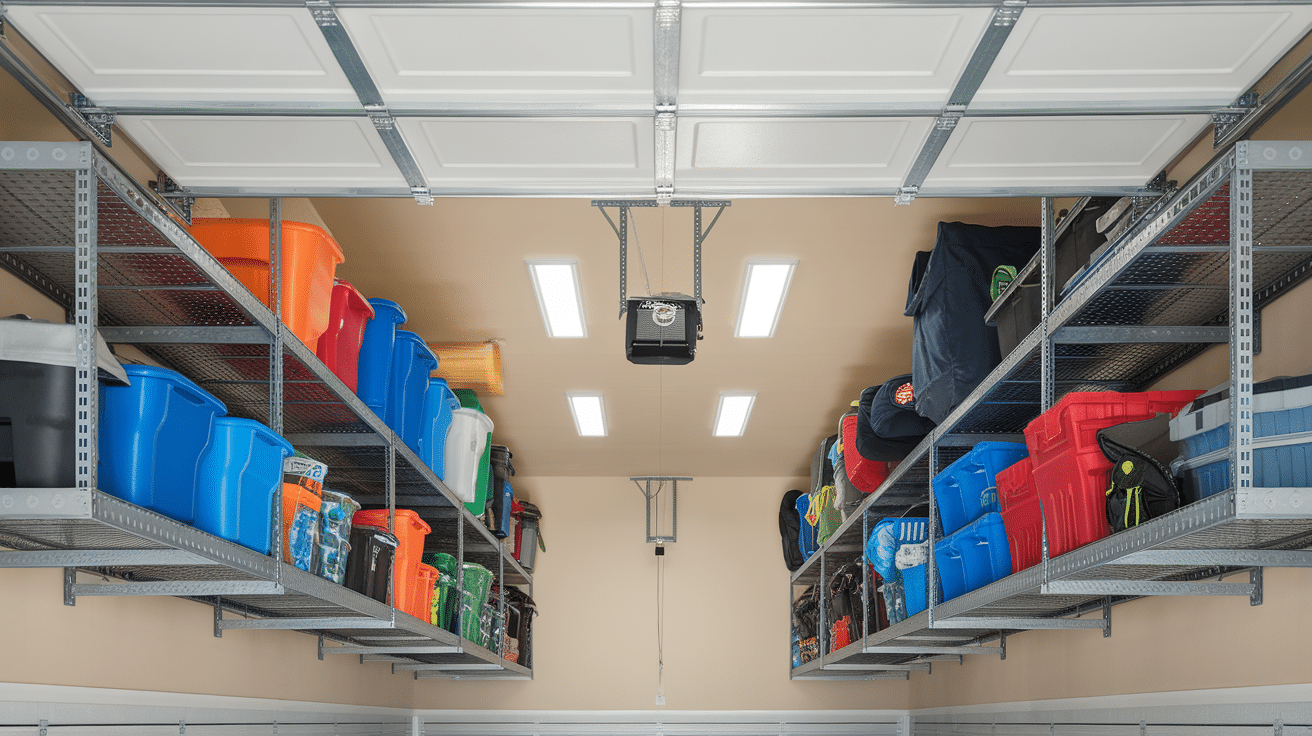
Use ceiling-mounted racks to store bulky seasonal gear like camping equipment, luggage, or holiday decorations. It keeps your floor clear and uses overhead space that’s often wasted.
This solution works especially well in smaller garages where vertical space matters most.
Additional Home Organization Ideas for Every Space
Some organizing tricks work in every part of the home, from kitchens and bedrooms to garages and offices. These ideas are flexible, practical, and easy to maintain – no matter your space or schedule.
- Use Matching Labels: Labels create a sense of order and make it easy to find what you need fast. When every container and drawer has a clear tag, clutter doesn’t stand a chance.
- Add Wall Hooks: Hooks are perfect for hanging jackets, towels, or accessories. They keep everyday items off the floor and free up valuable counter or shelf space.
- Try Clear Storage Bins: Transparent bins let you see what’s inside right away, so you never lose track of what you have. They’re ideal for closets, laundry rooms, and pantries.
- Include Floating or Wall Shelves: Wall shelves help you use vertical space better. They work for décor, books, or small baskets that hold daily essentials.
- Use Baskets and Bins for Grouping: Grouping items by category keeps things easier to find. Try woven baskets for soft storage or sturdy plastic ones for tools and cleaning products.
- Keep a Donation Basket Handy: A simple bin for unwanted clothes, toys, or home items helps prevent buildup. Once it’s full, donate it and start again – it’s an easy clutter cycle to manage.
- Set Up a Weekly Reset Routine: Pick one day to tidy each room for 10–15 minutes. These quick resets stop clutter from turning into a bigger cleaning project later.
- Add Over-the-Door Organizers: Doors are often unused space. Use them to hang shoe racks, cleaning supplies, or craft materials to keep small items within reach.
- Use Drawer Inserts Everywhere: Drawer dividers aren’t just for kitchens. They work in bathrooms, dressers, and desks to separate small items neatly.
- Create a Charging Station: Use one tray or box to keep chargers, cords, and devices together. It reduces cord clutter and keeps electronics easy to find.
- Rotate Seasonal Items: Store out-of-season clothes or décor in labeled bins. Swap them out every few months so only what you need is in sight.
- Add Lazy Susans in Cabinets: A spinning tray keeps spices, cleaning supplies, or toiletries accessible. It’s a small upgrade that works in kitchens, bathrooms, and offices alike.
- Use Under-Furniture Storage: Slide low-profile bins under beds, couches, or benches for things like linens, shoes, or toys. It’s hidden storage that keeps floors clear.
- Store by Frequency of Use: Place frequently used items at eye level and seasonal or rarely used items up high. This makes daily organization feel natural and effortless.
- Keep Surfaces Clear: Limit each tabletop or counter to just a few useful or decorative items. This instantly makes your home feel neater and easier to maintain.
- Use Labels by Color: Assign color-coded labels or bins to family members or categories. It’s a quick visual cue that keeps everyone organized with minimal effort.
- Set a One-In, One-Out Rule: For every new item you bring in, remove something you no longer use. This keeps clutter from sneaking back in.
- Add a Family Calendar Board: A shared calendar helps track schedules, chores, and reminders. Hang it in a central place to keep everyone on the same page.
- Store Items Vertically: Instead of stacking, store books, lids, or trays upright. It saves space and makes things easier to grab without unstacking everything.
- Keep a “Catch-All” Basket in Each Room: Use a basket to collect items that don’t belong. Empty it at the end of the day to keep every room clutter-free.
These extra ideas bring flexibility and consistency to your entire home. Start adding them one at a time – you’ll quickly see how small habits can keep every corner organized without feeling overwhelming.
Conclusion
Keeping your home organized doesn’t have to be a huge project. When you break it down room by room and use simple systems that fit your lifestyle, everything becomes easier to manage.
The key is to create spaces that make daily life smoother – not picture-perfect, just practical.
Start small by tackling one area at a time and stick with habits that feel natural, like labeling or doing quick weekly resets. Over time, you’ll notice how much calmer and more functional your home feels.
Organization isn’t about perfection; it’s about creating balance and making your space work for you. Once everything has a place, you’ll spend less time searching and more time enjoying your home.
